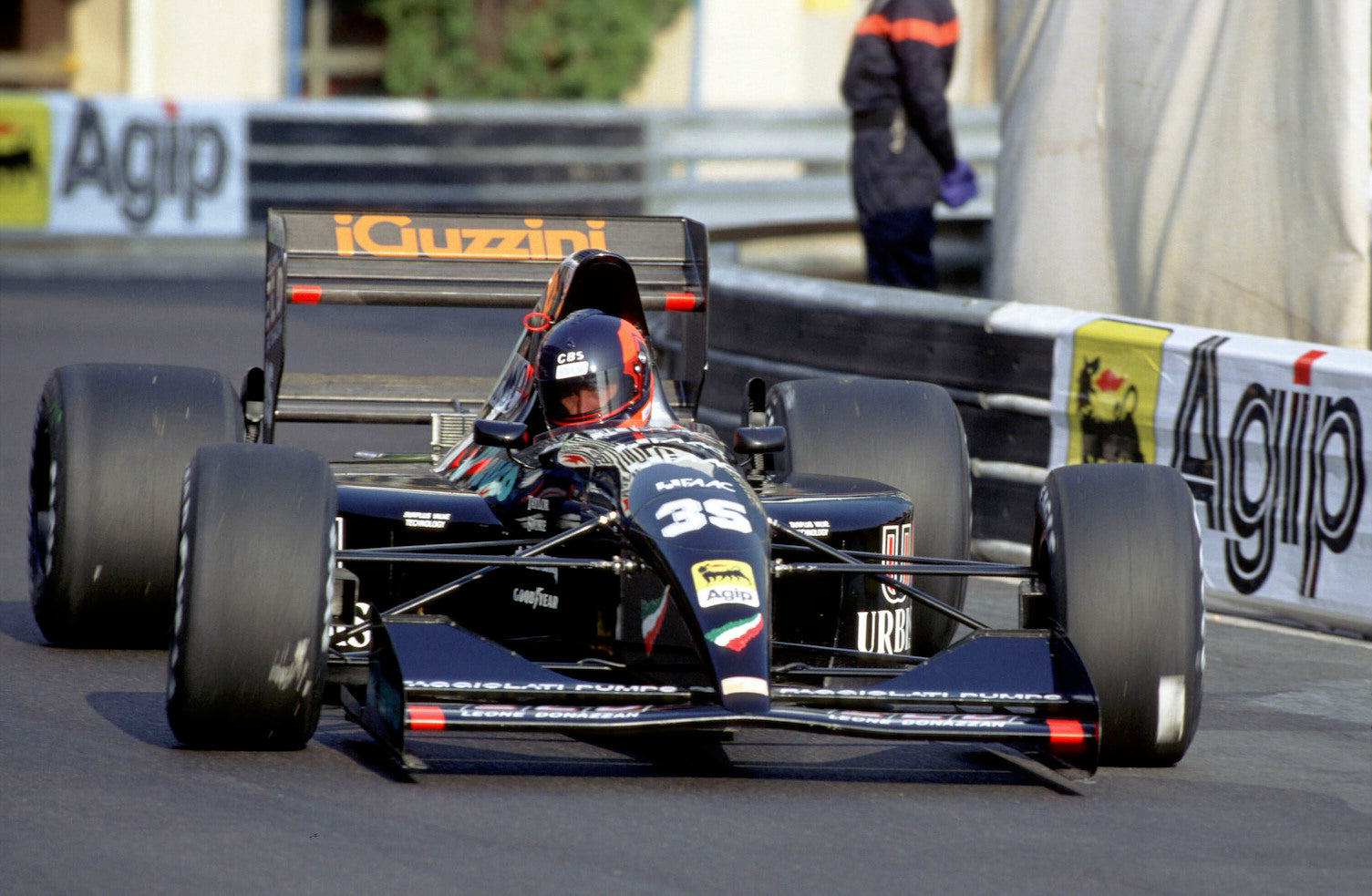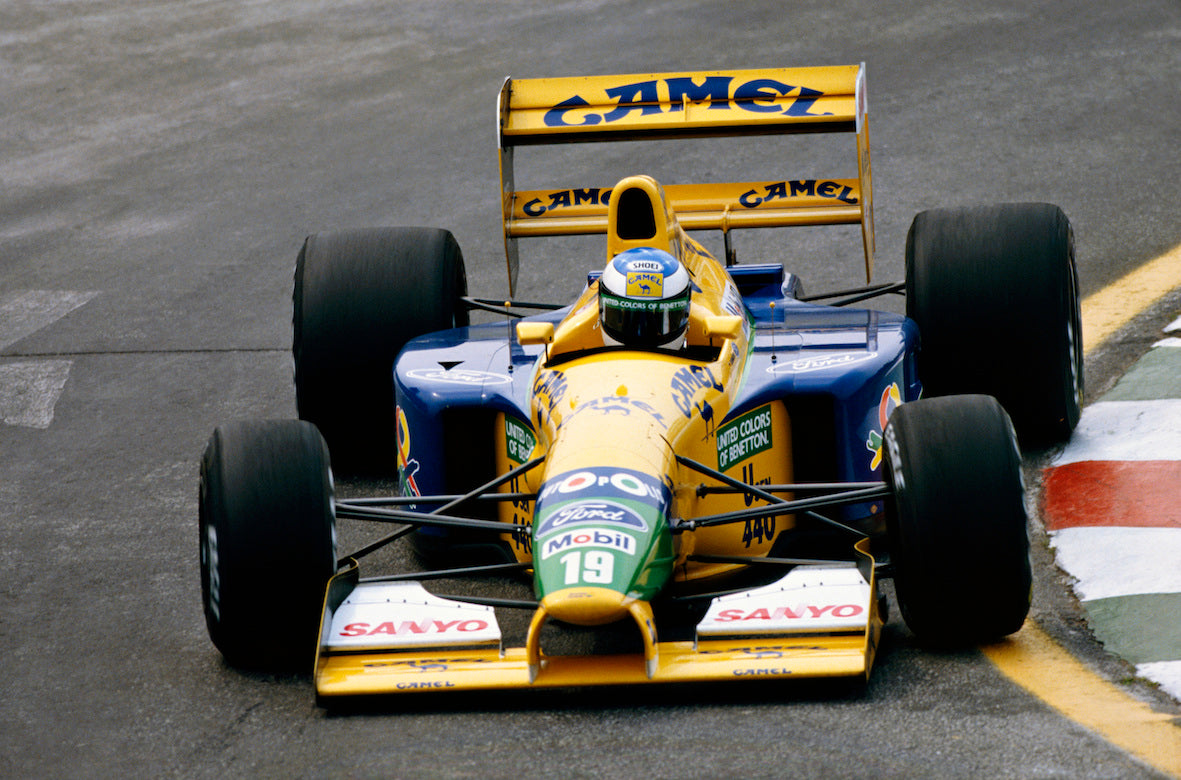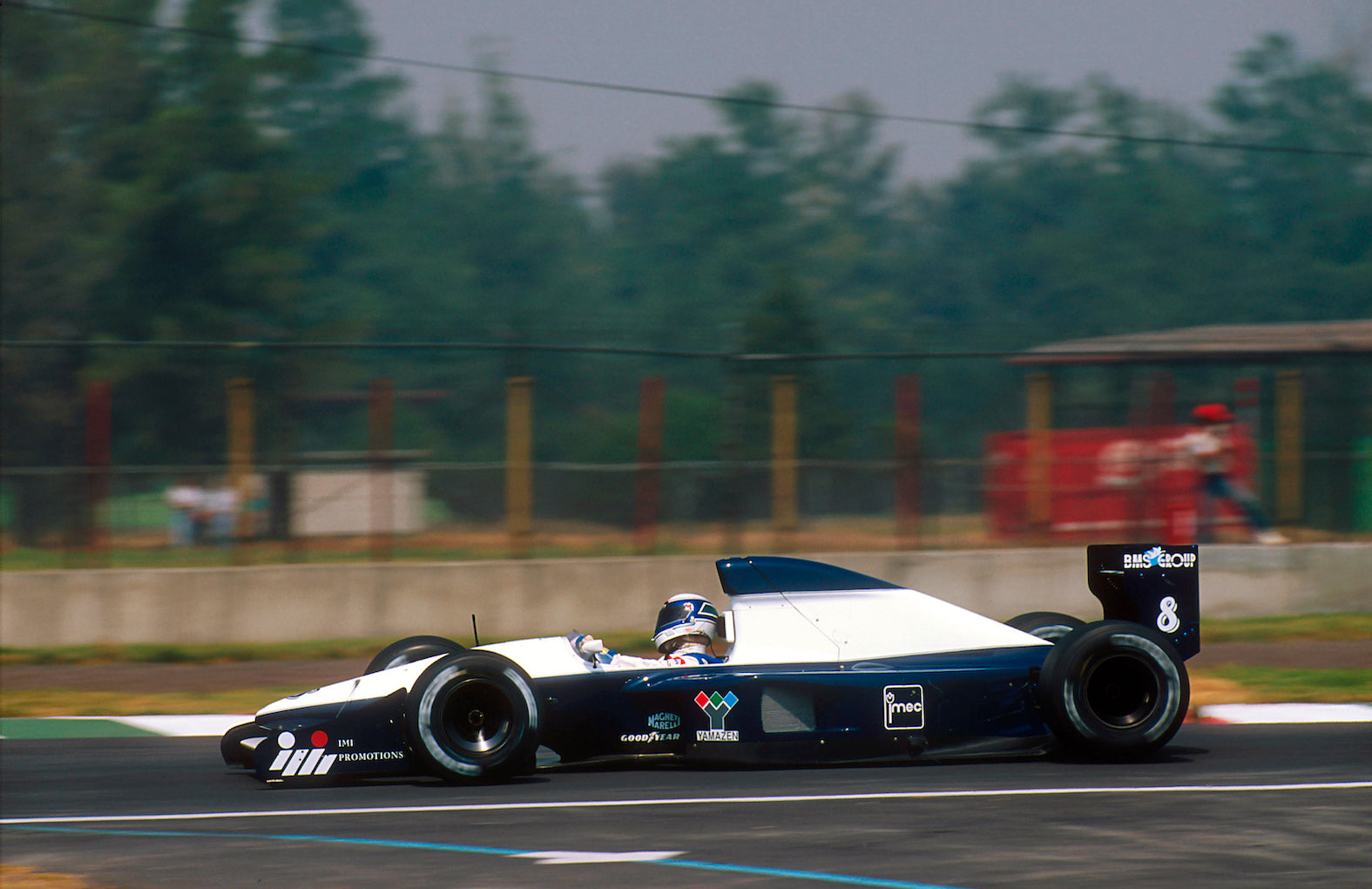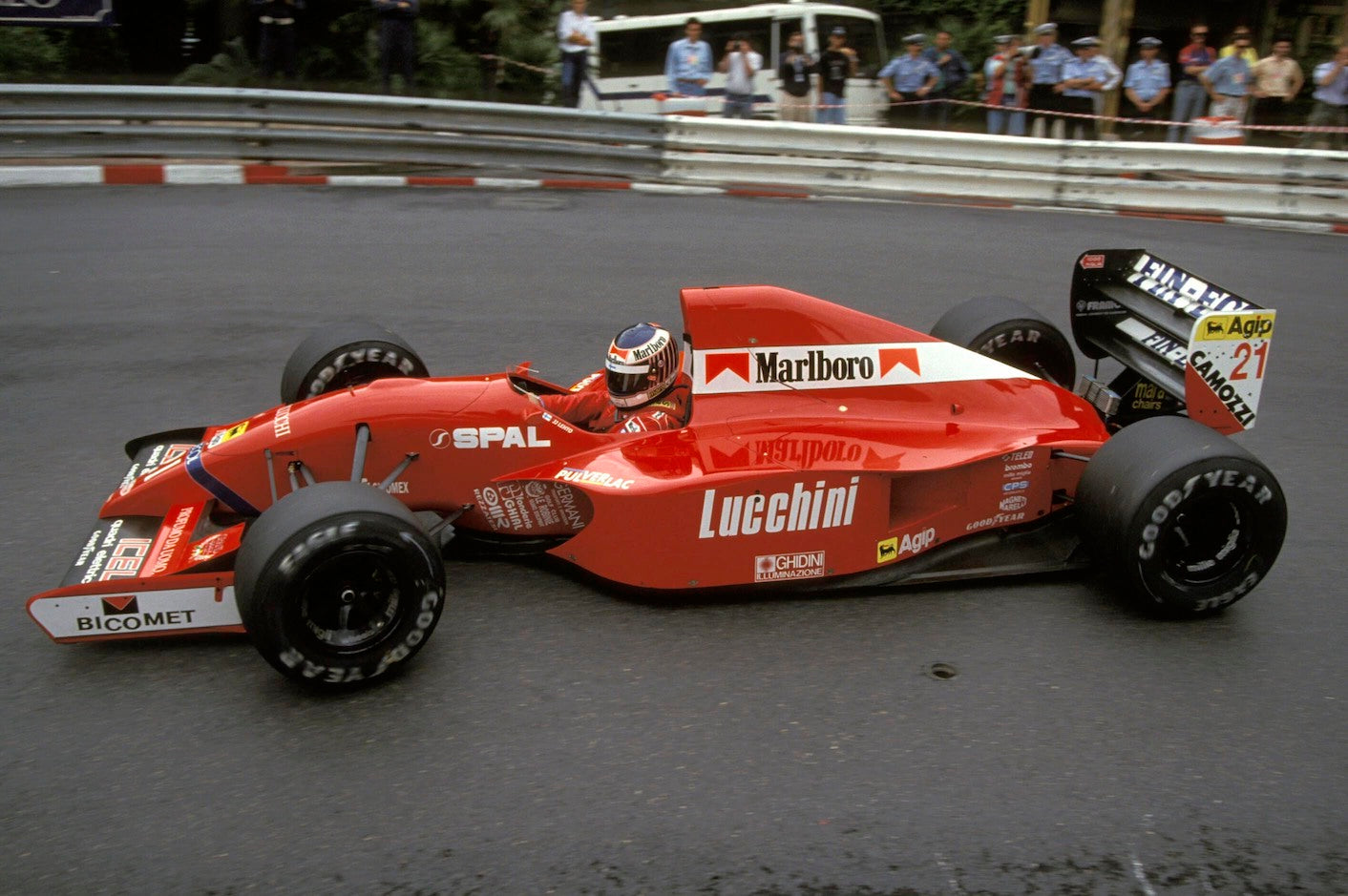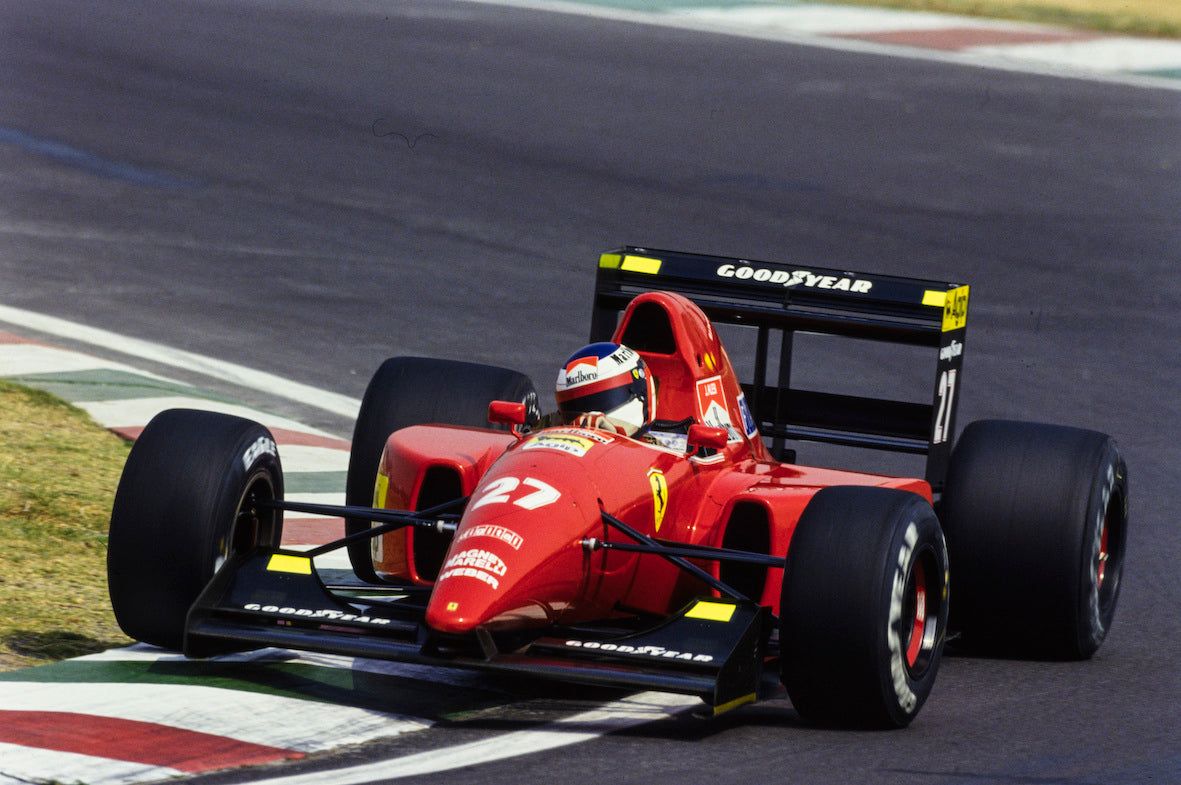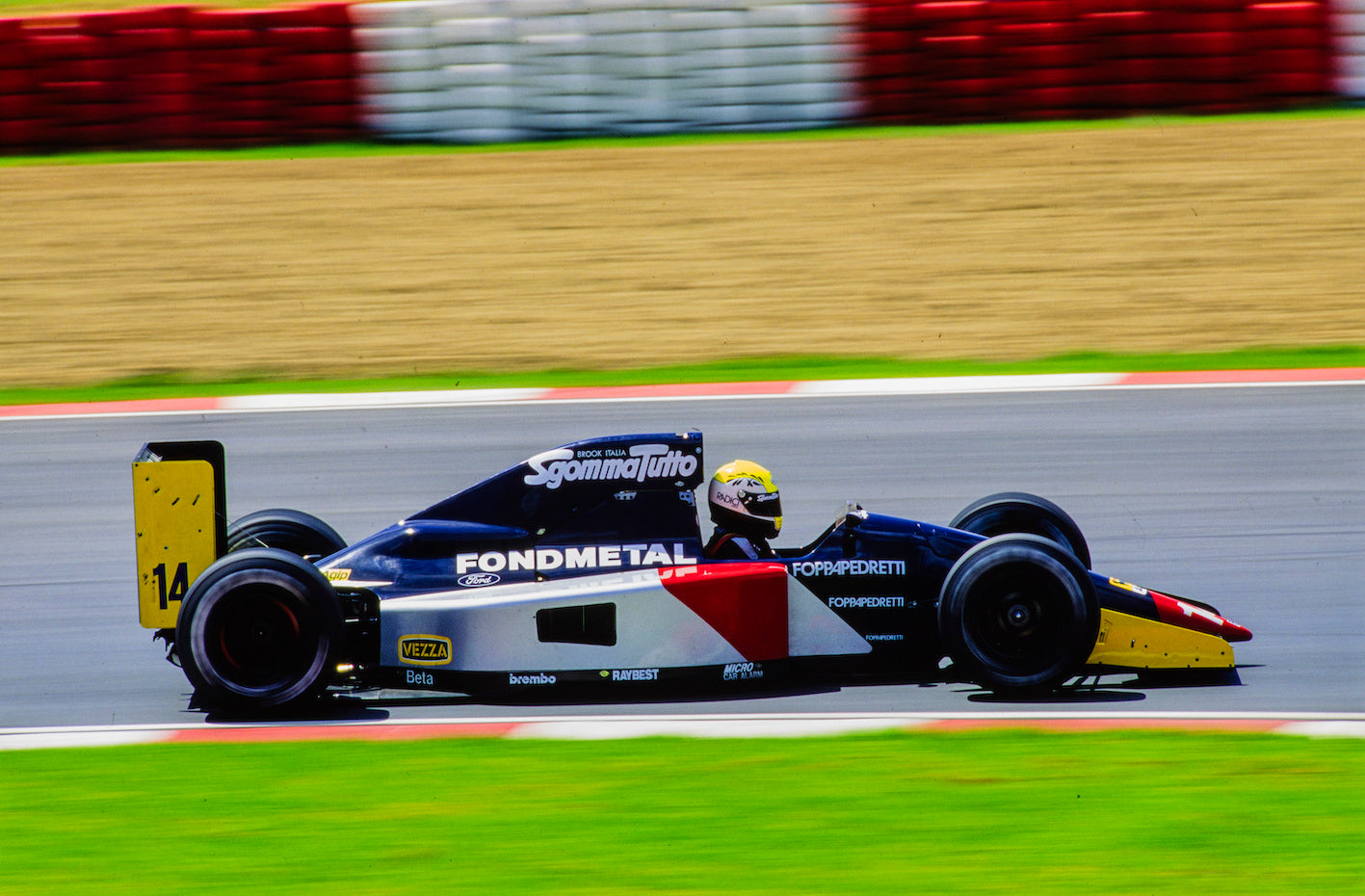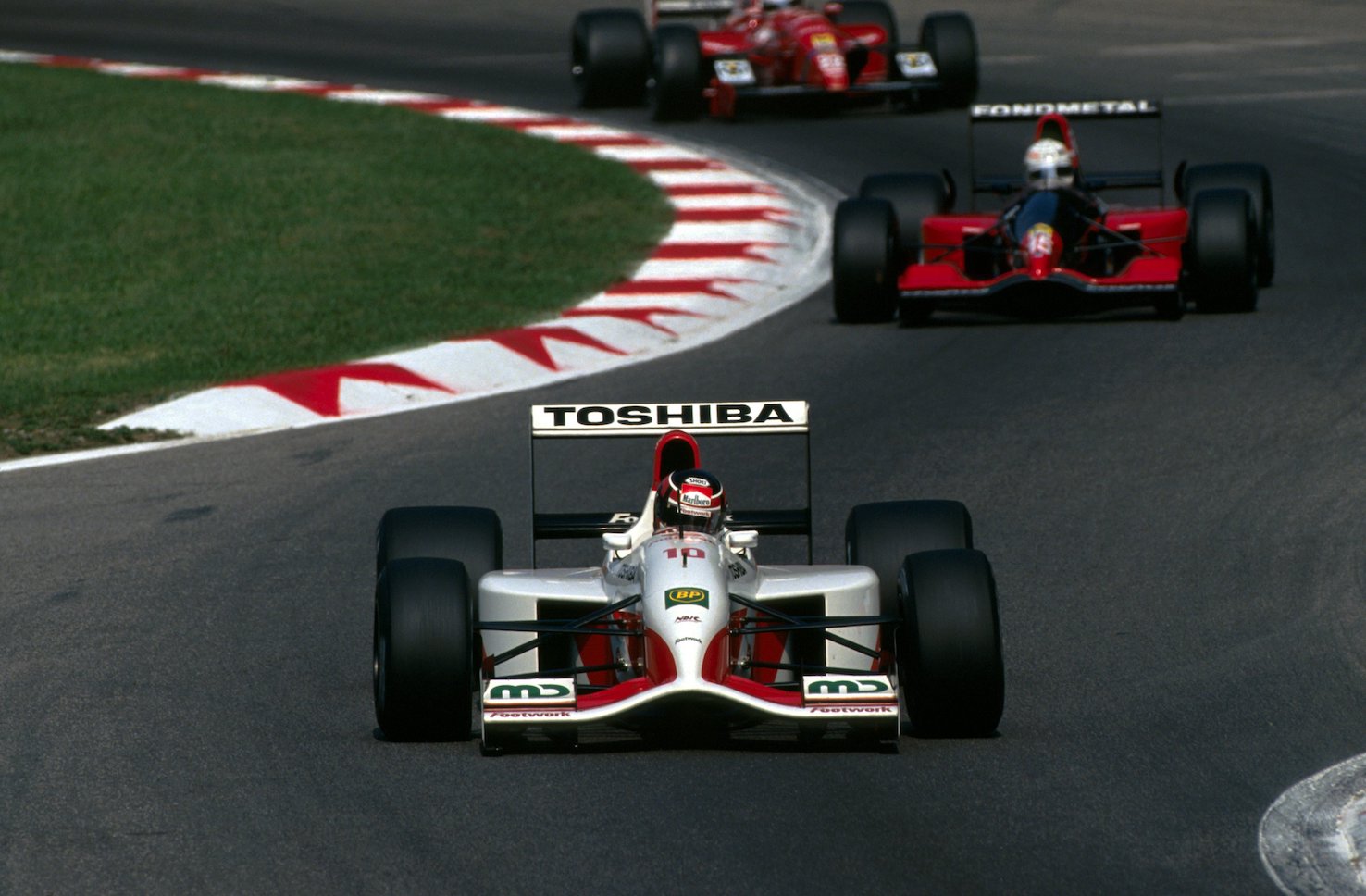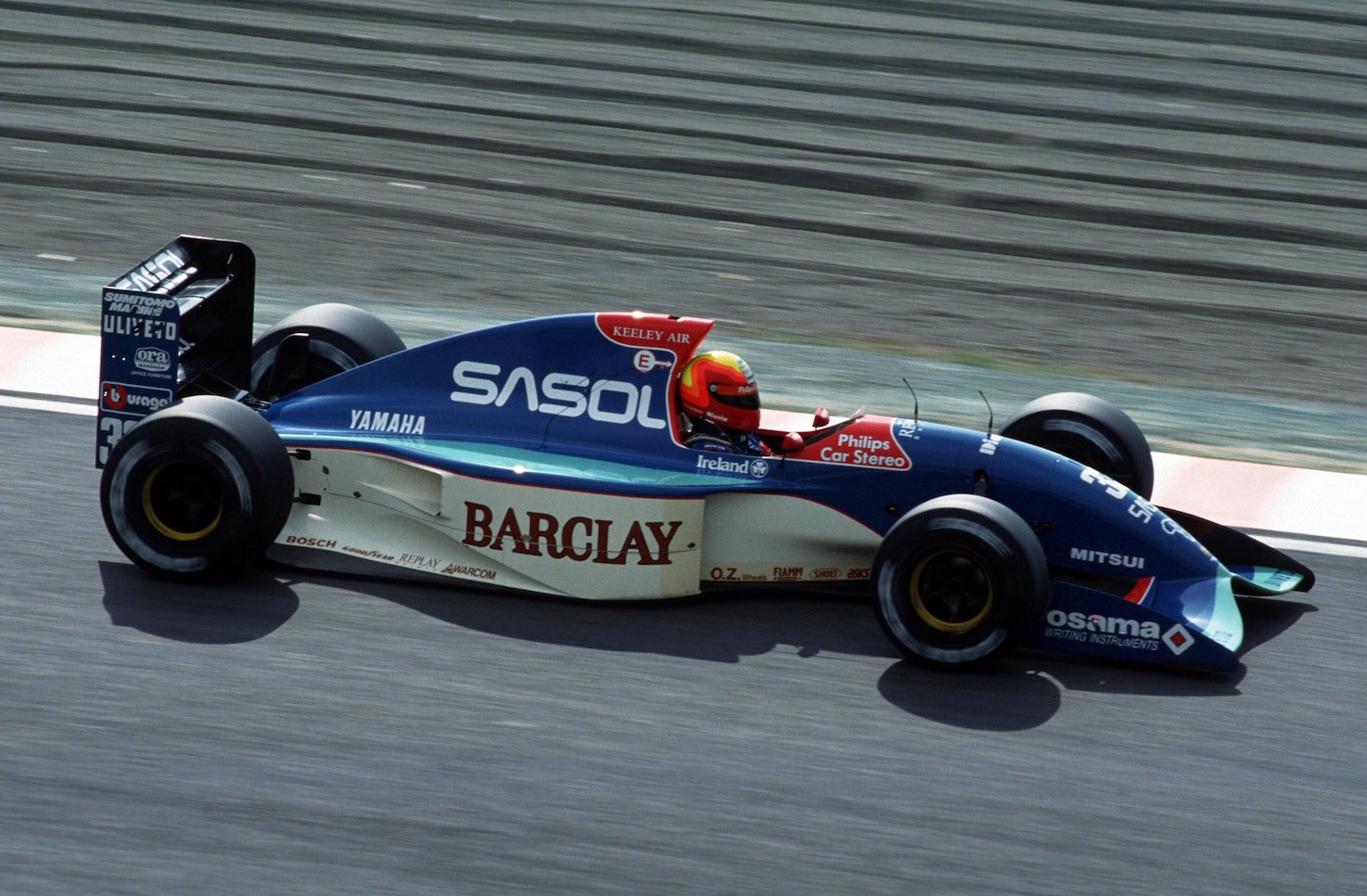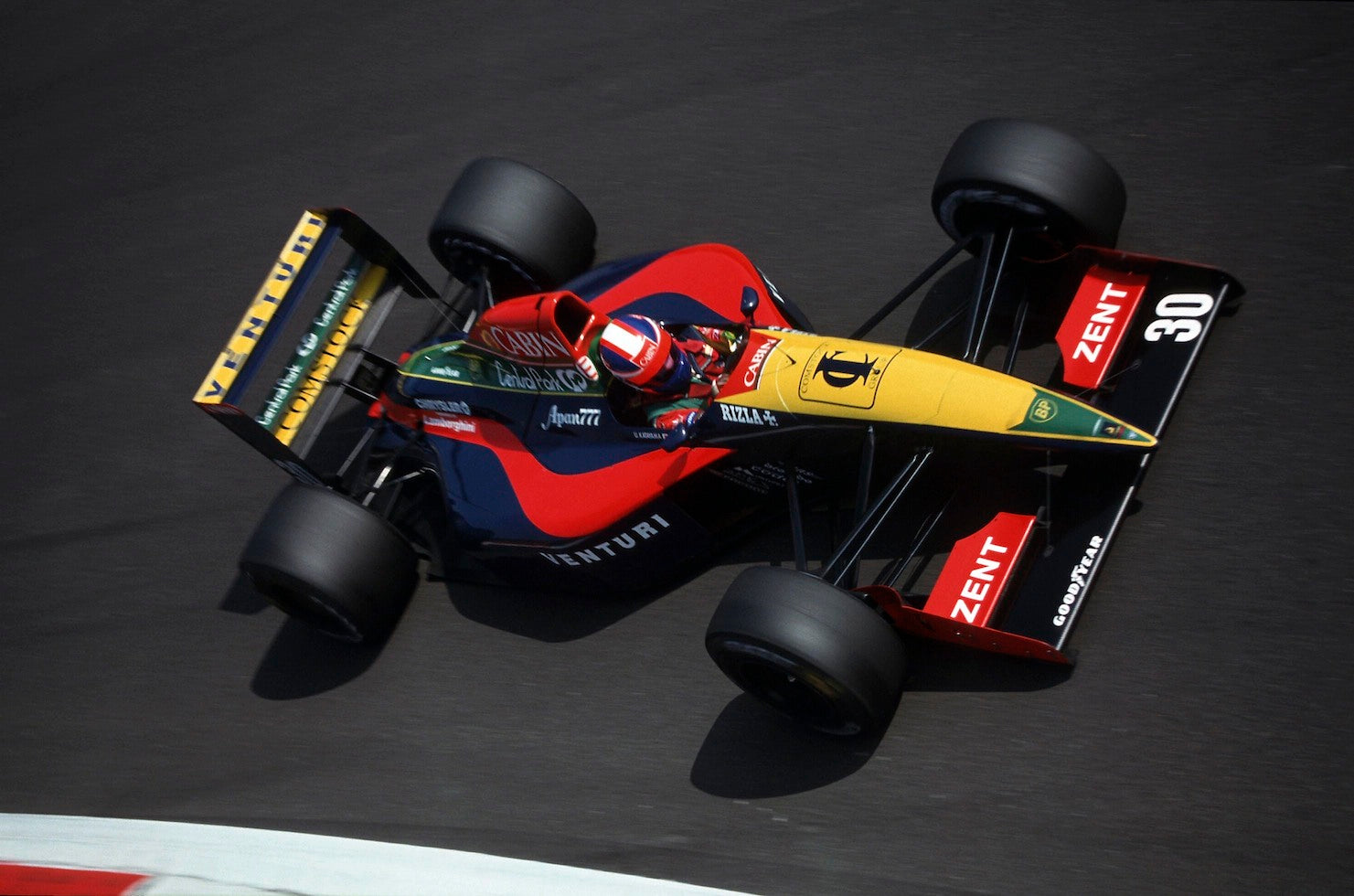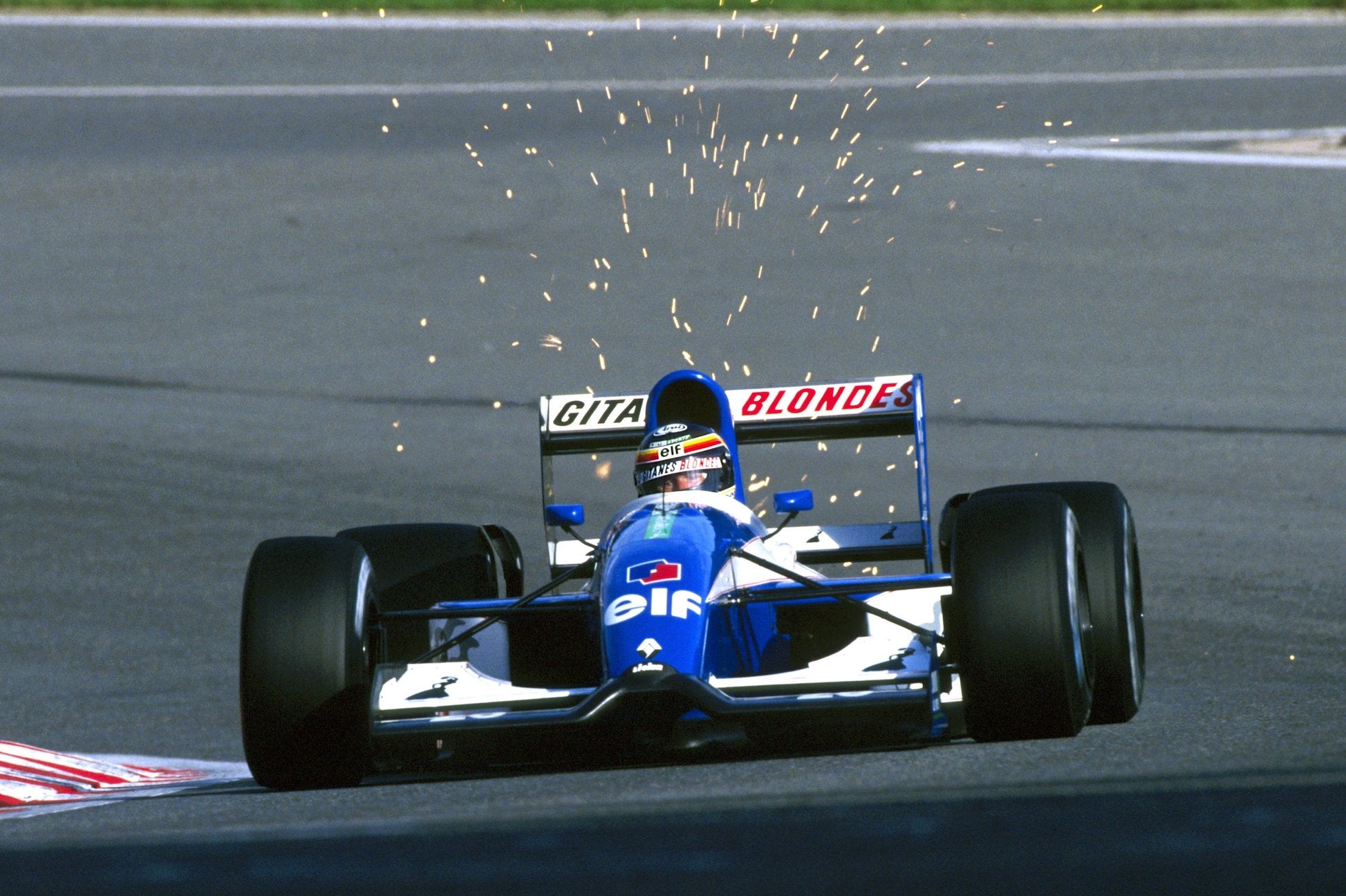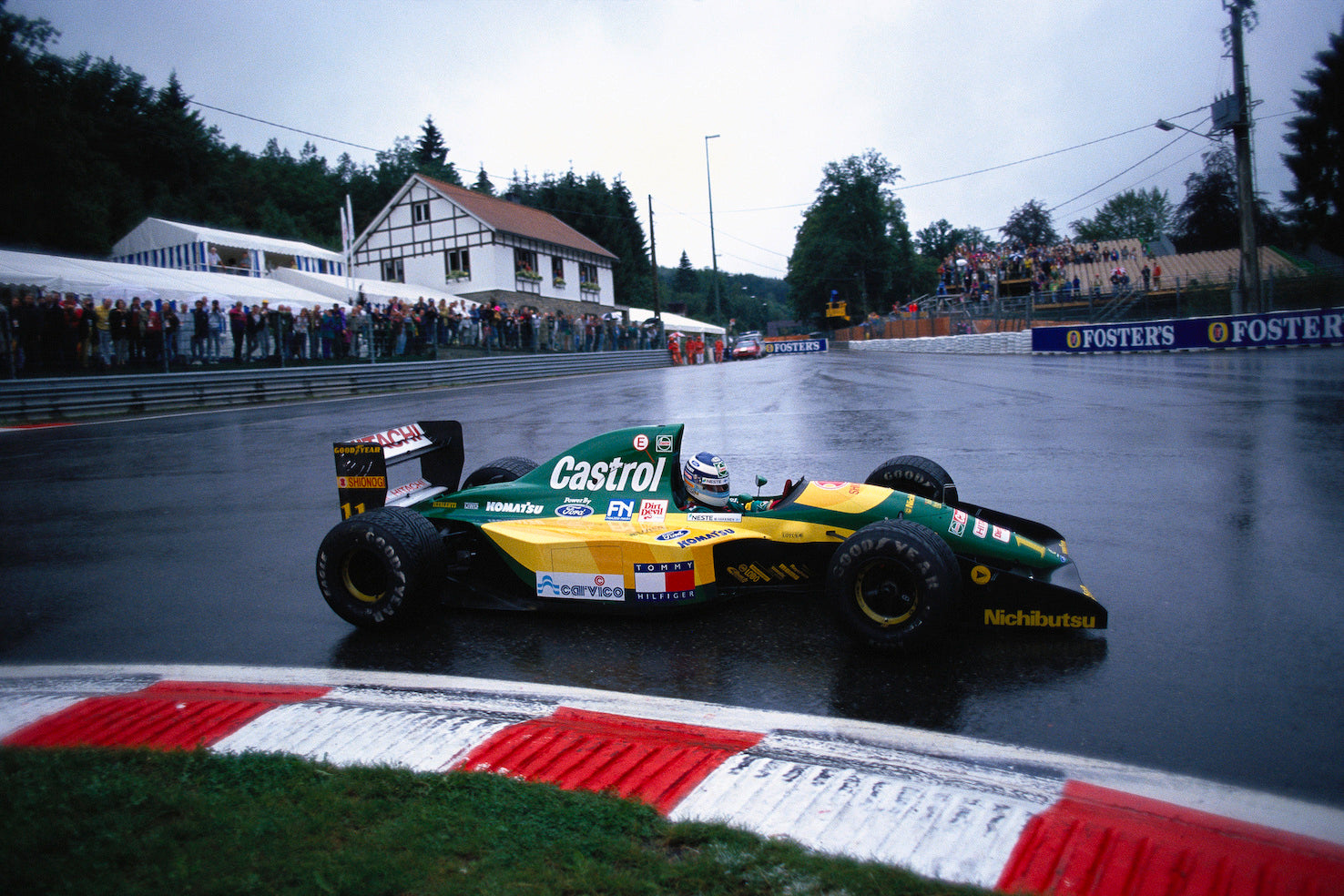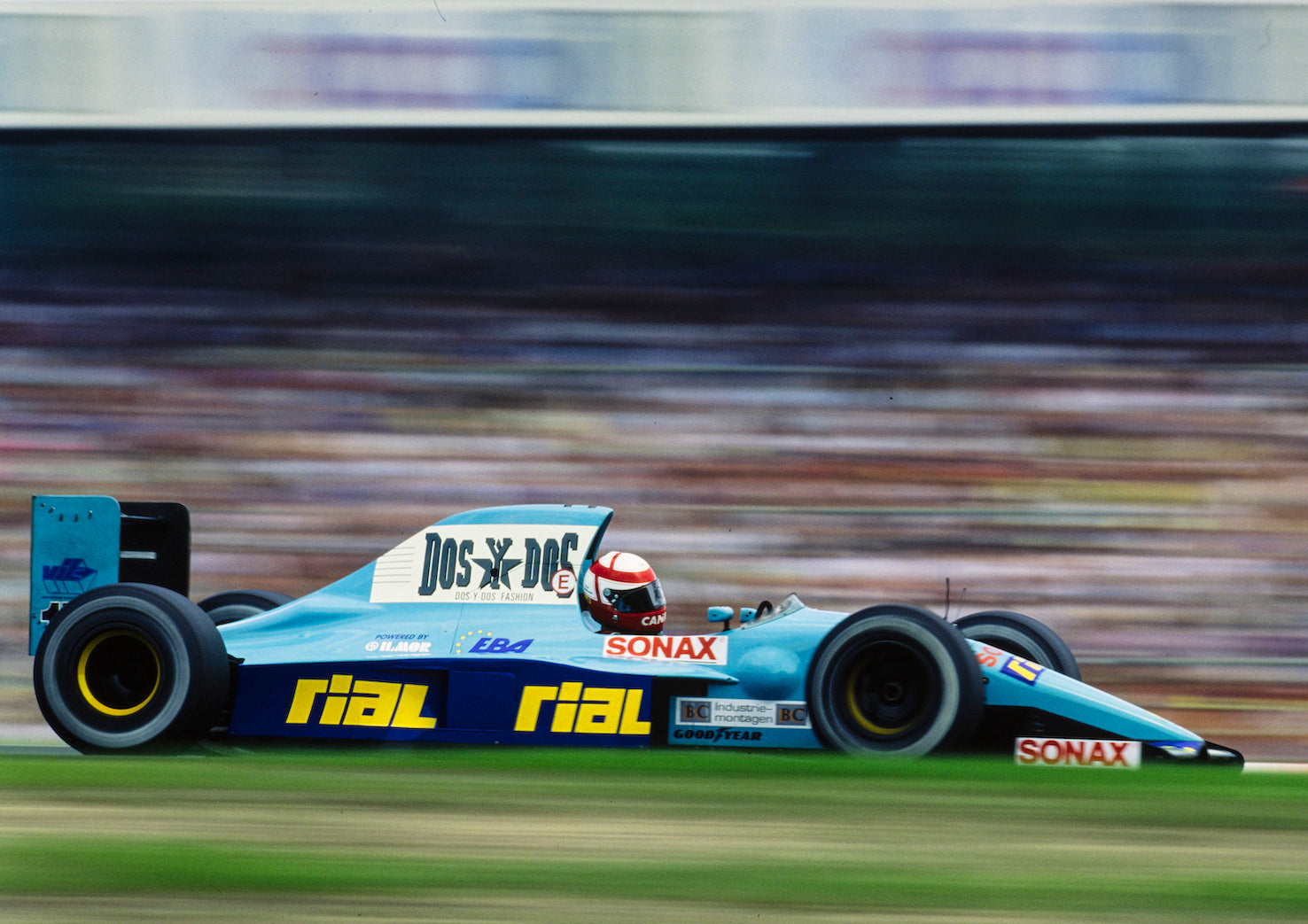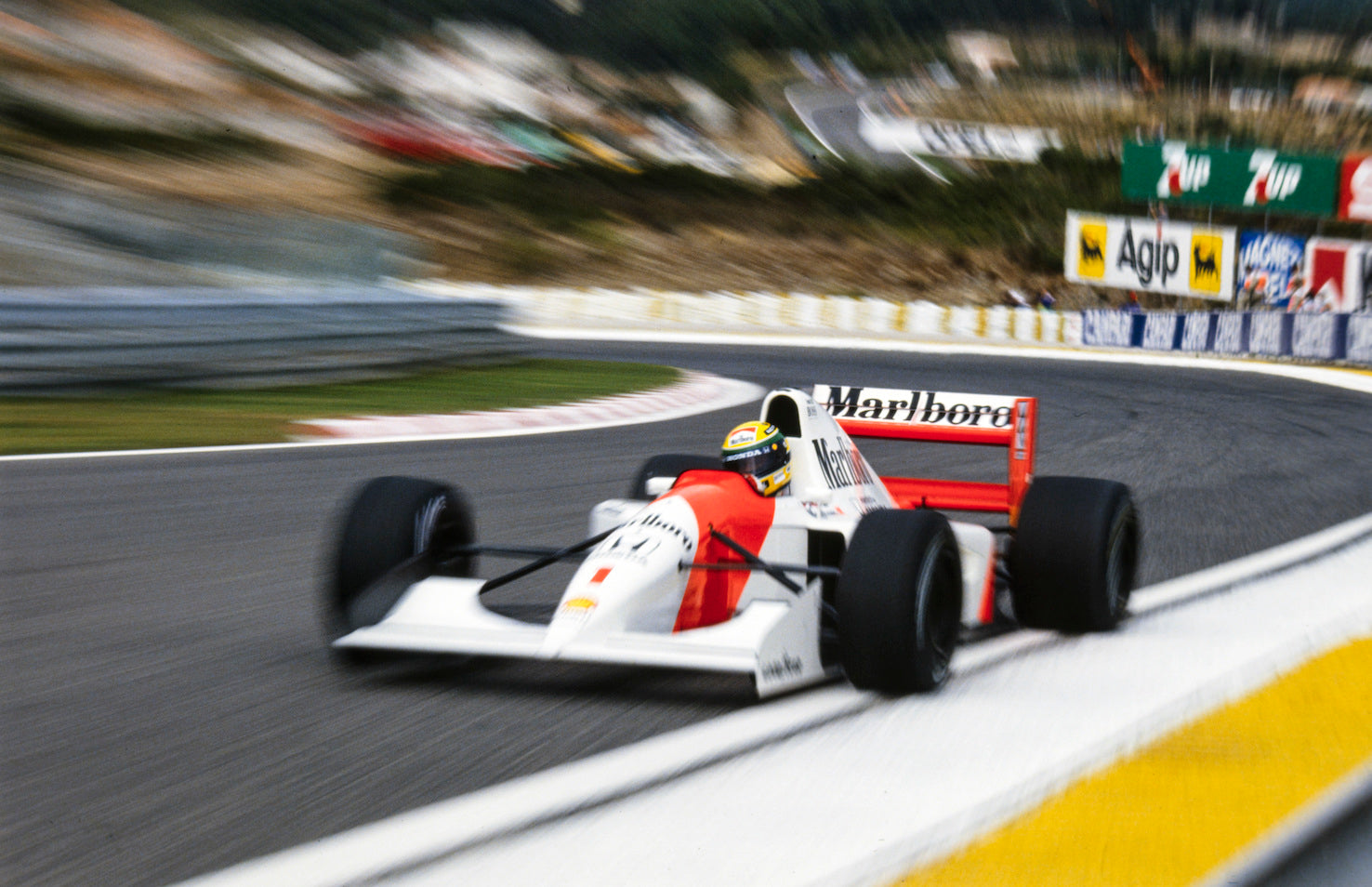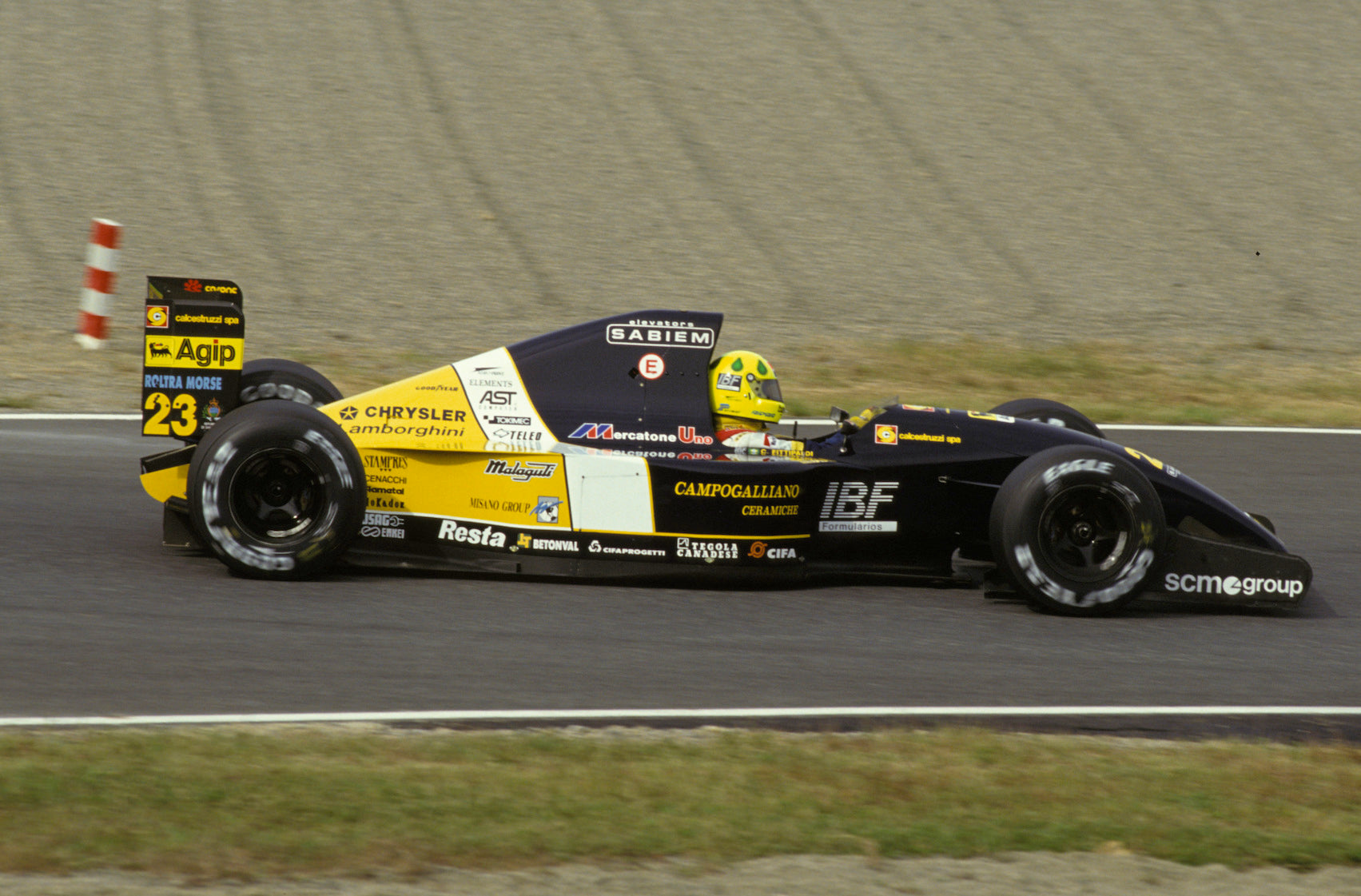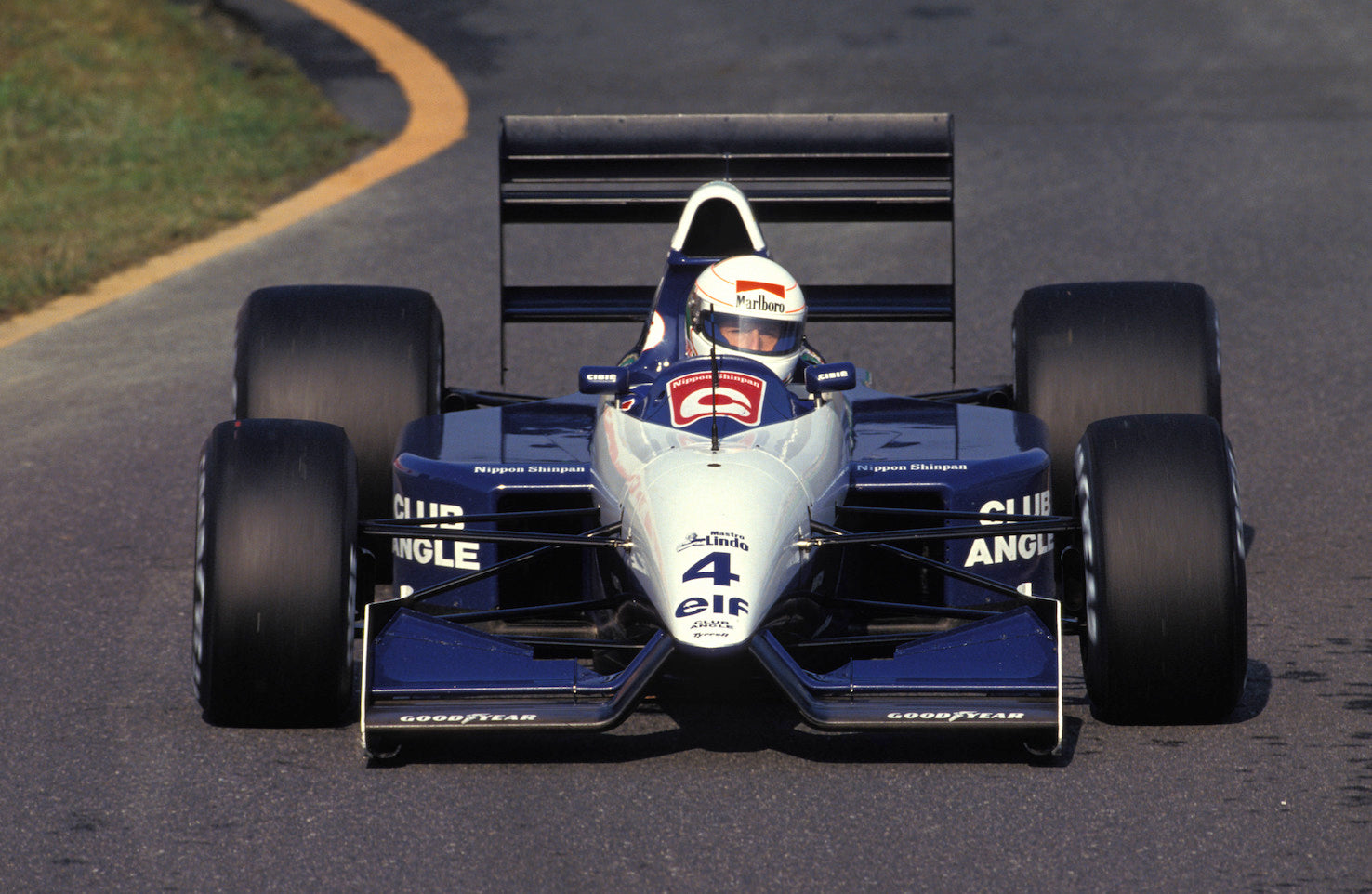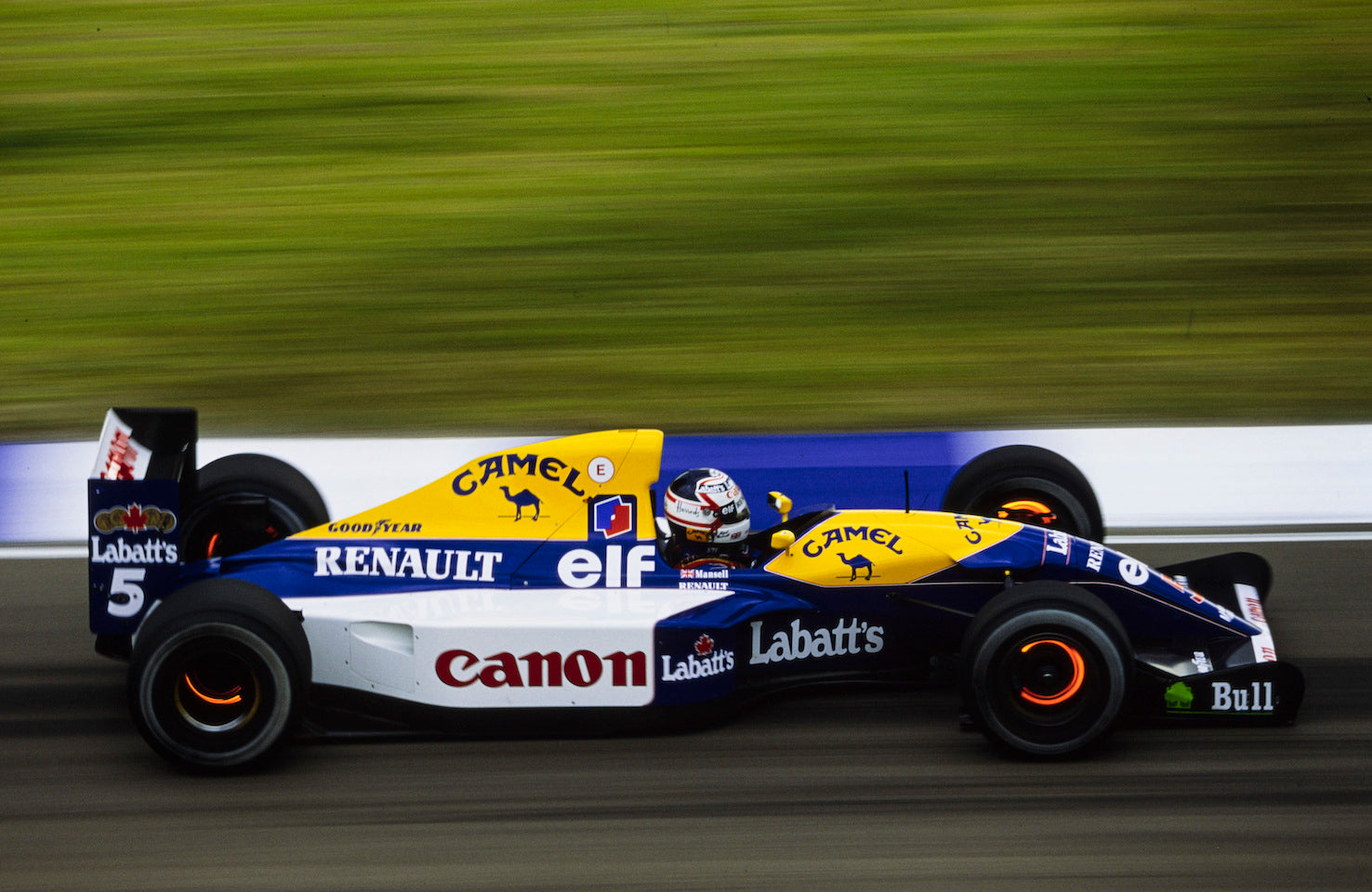Formula 1: Car by Car 1990–99
- In stock, ready to ship
- Inventory on the way
1992
MANSELL AND WILLIAMS FW14B DOMINATE
After 12 years of drama and heroics, Nigel Mansell finally won the World Championship in 1992, and promptly quit F1. His Williams FW14B was the most sophisticated car seen to date and the Renault V10 now outgunned Honda’s V12, so the Englishman enjoyed a season of rare domination.
For the first time in history, the World Championship visited all six inhabited continents with Kyalami hosting the first South African GP since 1985. The impressive new Nippon Autopolis was to have held the Asian GP on 5 April but the race was cancelled amid financial problems. The European GP was scheduled at Jerez (4 October) although that too was cancelled when the calendar was limited to 16 races as preferred by the teams. There was no United States GP although Tony George announced in July that Indianapolis wanted to attract both F1 and NASCAR to the Brickyard.
TAG Heuer superseded Longines as F1’s official timekeeper. Peter Warr replaced Jan Corsmit as F1’s permanent steward for this season only and chief scrutineer Charlie Whiting was named as the championship’s technical delegate. English replaced French as the official language of F1 rules and regulations. Special fuels boosted hydrocarbons and increased power but the Fédération Internationale du Sport Automobile issued a clarification ten days before the Hungarian GP, imposing commercial pump fuel with immediate effect. It was a controversial move that prompted legal action from Renault and Elf that rumbled on until a compromise was agreed for 1993.
The recession started to bite and mechanics were laid off at some teams during the winter of 1991/92. Andrea Moda (née Coloni), Brabham, Fondmetal (Osella) and March all started a GP for the last time in 1992. John Barnard worked as a consultant for Toyota’s development arm TOM’s (Tachi Oiwa Motorsports) but no F1 programme was sanctioned. Reynard tested a scale model of its F1 design in Imperial College’s wind tunnel during 1991 before the project was shelved when a deal with Yamaha fell through and a suitable alternative could not be found. Giuseppe Cipriani’s ambitious Il Barone Rampante F3000 team planned to graduate. Enrique Scalabroni began designing a chassis in August 1991 and Flavio Briatore brokered a deal to take over Jordan’s Ford HB contract. Without the facilities to build the car in time, there was talk of buying Tyrrell or Fondmetal but the deal foundered.
Goodyear supplied the whole field following Pirelli’s withdrawal so qualifying tyres were not required. Any tyre manufacturer wanting to enter the category in the future had to supply at least 25 per cent of the field.
CANON WILLIAMS TEAM
Williams updated its 1991 design with traction control and ‘reactive’ suspension as standard, the computer-controlled ride-height system now reliable following 7,000 winter testing miles. An automatic clutch was tried before Christmas but was only raced after both 1992 titles had been secured in Belgium. The FW14B was so dominant that its replacement (FW15) was not risked when it was completed in September.
Continuity also extended to the cockpit as Nigel Mansell and Riccardo Patrese were confirmed on 13 August 1991 with Damon Hill as test driver once more. Patrese’s contract extension was a surprise to Ayrton Senna, who had spoken to Williams. Al Unser Jr, the 1990 Indycar champion, tested for Williams at Estoril during the week of 18–23 November 1991 but his much-anticipated F1 switch never happened.
Dominant in winter testing, Mansell won the opening five races (a record) from pole position with Patrese second at Kyalami, México City, Interlagos and Imola. Williams-Renault led every lap of those five races and only Patrese’s crash in Spain prevented a fifth 1–2. The Italian then suffered whiplash and a bruised shoulder when he crashed heavily during the following week’s Imola test after a tyre punctured at Tamburello.
Williams’s winning run ended in Monaco when, believing he had a puncture, Mansell changed tyres with seven laps remaining. He caught new leader Senna but could not find a way past the ‘wide’ McLaren-Honda and lost by 0.214sec with the oversteering Patrese third. Senna beat the Williams-Renaults to pole in Canada and led Mansell until lap 15. The Englishman lunged for the inside line at the chicane before the pits and lost control on the ‘marbles’ with his Williams-Renault launched over the kerb and out of the race. Mansell confronted McLaren’s Ron Dennis and complained to the stewards but the consensus was that it had been his mistake. ‘A more championship-minded driver would have weighed the odds,’ David Tremayne wrote in Motor Sport, ‘considered waiting a little longer to see how things developed and in any case wouldn’t have tried down the inside of an area known to be slippery.’ Patrese was second when his gearbox broke.
Canada was a blip as Mansell led Williams 1–2s in qualifying and race at Magny-Cours and Silverstone, where his home victory prompted an unruly track invasion. Normally overshadowed by Mansell, Patrese made the better start and restart in France, where he ostentatiously waved Mansell through in front of the pits. Unsettled since the spring by talk of Alain Prost joining Williams in 1993, Mansell then converted a third successive pole position into another victory at Hockenheim to stand on the cusp of the World Championship. Patrese spun away a podium finish while trying to take second from Senna on the last lap.
Mansell raced the new RS04 version of Renault’s V10 engine for the first time in Hungary. Smaller than the RS03C and with new block, cylinder heads and crankshaft, it had improved torque and better fuel consumption. With the McLaren-Honda suited to the sinuous Hungaroring, Mansell qualified second, ran fourth after the start, changed tyres following a puncture and climbed from sixth to second to clinch the title with five races to spare. Patrese started from pole and had a 30sec lead when he spun down to sixth place, after which his engine failed, a fault that may have been connected with FISA’s insistence that commercial fuel be used from that race.
Williams was confirmed as constructors’ champion after finishing second and third in Belgium, despite more engine troubles. Both drivers led in Italy only for hydraulic failures to eliminate Mansell and leave Patrese stuck in gear as he limped home fifth. Unhappy at Prost’s imminent arrival and having announced his decision to defect to Indycars in 1993, Mansell scored his then-record ninth victory of 1992 at Estoril. Patrese was lucky to escape injury when he hit Gerhard Berger as the McLaren-Honda darted for the pits, his Williams-Renault launched into an end-over-end roll. In Japan, Patrese scored his sixth career victory after Mansell handed him the lead prior to an engine blow-up.
A triumphant campaign ended in more controversy when Senna crashed into Mansell as they disputed the lead in Adelaide. ‘Senna has no place on the track,’ the champion raged. ‘He has a screw loose in his head.’ New leader Patrese lost fuel pressure but was confirmed as championship runner-up when Michael Schumacher did not win.
HONDA MARLBORO McLAREN
McLaren-Honda needed extensive in-season engine development in 1991 to retain both World Championships for the fourth successive season and so development work on the 1992 version of Honda’s V12 was delayed. The new RA122E had a revised vee-angle (from 60 to 75 degrees), variable-length trumpets and pneumatic valves. Some increased internal frictional losses initially reduced power while both performance and tyre wear were compromised by the heavy fuel load required.
There were vague rumblings of offers for Ayrton Senna’s services from both Ferrari and Benetton before he re-signed with McLaren on 17 September 1991 while Gerhard Berger remained in the final year of his deal. Benetton’s Giorgio Ascanelli was poached as Senna’s race engineer while Berger continued to work with Steve Hallam. Dropped by Brabham, Mark Blundell joined Allan McNish as test driver. McLaren took over Ferrari’s Guildford Technical Office to produce its new road car.
For the first three races McLaren decided to use an updated MP4/6B with a longer nose and redesigned front wings. Stunned by Williams-Renault’s speed and reliability in testing, Ron Dennis accelerated development of the new McLaren MP4/7A-Honda by a month. Having lost the opening race at Kyalami by 34.675sec, third-placed Senna told the press: ‘There is no way I can fight the Williams. I can play a little, like today with Riccardo [Patrese], but no more than that.’ His Mexican GP was a disaster for he wrote off his race chassis on Friday, badly bruising his legs, only qualified sixth and retired from third due to transmission failure. After Berger’s fuel-saving fifth in South Africa, he had his own accidents during Mexican practice and finished fourth as McLaren lagged behind both Williams and Benetton.
McNish conducted the MP4/7A’s shakedown at Silverstone on the day after the South African GP before Blundell took over. Neil Oatley’s design team (Henri Durand, David North, David Neilson and Matthew Jeffreys) eschewed McLaren’s normal evolutionary approach as every part was reassessed. TAG Electronics developed the new automatic transverse six-speed gearbox and electro-hydraulic clutch, which was operated by buttons on the steering wheel with back-up paddle shift if needed. The fly-by-wire throttle allowed the driver to change gear without lifting and traction control was introduced in Hungary. Conventional push-rod suspension via unequal wishbones was standard while the active MP4/7B was tried in Italy but not raced, its computer-controlled suspension developed in conjunction with Showa. New production methods were employed for the narrow carbon-fibre monocoque, the high and slim sidepods housed repositioned radiators and a raised nose was adopted for the first time.
Senna drove the MP4/7A at Silverstone on 11–12 March and three new chassis were sent to Interlagos in addition to the three MP4/6Bs used in Mexico. With 81 team members at the race, this unprecedented show of technical commitment and financial might was not a success. Both MP4/7As started from the second row of the grid but retired by lap 18, Senna after criticism by the Benetton drivers for blocking. With the MP4/7As proving to be unstable in high-speed corners and having to carry up to 60lb more fuel at the start, the cars continued to disappoint as Berger managed fourth place in Spain and Senna third at Imola, where Berger walked away from a big accident while testing and retired after contact with Jean Alesi’s Ferrari.
In Monaco, Senna crucially forced his way past Riccardo Patrese at the start and took the lead when Mansell pitted. He then defended brilliantly to hold off a quicker car on new tyres to score an unexpected fifth victory in the Principality, with Berger sidelined by gearbox failure. More competitive in Canada, Senna started from pole but collided with Mansell as they disputed the lead and retired due to an electronic glitch. Berger, having passed Patrese in the aftermath of the Mansell/Senna fracas, went on to win despite having to use the paddle-shift back-up after the gearbox buttons stopped working, and surviving a post-race scrutineering issue with his rear wing.
Senna was hit by Michael Schumacher on the opening lap in France and a CV joint failed moments after taking third in Britain. Berger blew his engine at Magny-Cours and as he crossed the line in fifth at Silverstone. Six days after the British GP, Japanese newspaper Asashi Shimbun reported that Honda was pulling out of F1, which was finally confirmed at the Italian GP. That left McLaren without an engine partner and Senna considering his future. ‘If I do not get a competitive situation I am not going to drive next year,’ he told reporters at Silverstone. ‘I would prefer to stay in Brazil preparing myself for another year… To race for second or third is not worth it.’
Senna withstood Patrese’s pressure to finish second in Germany and Mansell’s to win in Hungary, where Berger finished third. In Belgium, the field had to take avoiding action when Berger’s clutch failed at the start. Reckoning an alternative strategy was his only hope of victory, Senna stayed on slick tyres too long when it rained, eventually changing to wets to claim fifth. Senna won the Italian GP after the Williams-Renaults had problems and Berger passed the hamstrung Patrese for fourth on the last lap.
Berger was second in Portugal despite back pain and being hit by Patrese as he pitted; Senna was third after three stops and a late slow puncture. With his relationship with McLaren at an all-time low, Senna had engine failure on the second lap in Japan and crashed into Mansell while challenging for the lead in Australia. Second at Suzuka, Berger signed off his McLaren career by beating Schumacher to victory in that Adelaide finale.
This had not been a happy season although McLaren-Honda won five times and finished as runners-up in their last season together (until 2015). Berger scored just a point less than Senna in his best season with McLaren. However, fourth and fifth in the drivers’ standings were slim pickings by recent McLaren standards.
CAMEL BENETTON FORD
The 1991 restructure meant that Benetton effectively had two team principals, with Tom Walkinshaw responsible for team and technical, and Flavio Briatore for commercial affairs. Having raced sports cars for Walkinshaw since 1985, Martin Brundle signed as Michael Schumacher’s team-mate on 10 October 1991 and Alex Zanardi joined as test driver before the season. Gordon Message was team manager once more with Joan Villadelprat now factory-based. Pat Fry engineered Brundle’s car with Pat Symonds early in his long and fruitful relationship with Schumacher. Reliability was excellent and Benetton-Ford scored points at every race to take third in the constructors’ standings.
At the 1991 Canadian GP, Ford announced a new V12 engine for Benetton’s exclusive use but it never materialised, so the latest-specification Ford HBs were used. The move into the new 85,000sq ft Whiteways Technical Centre at Enstone was completed in October 1992, with those based at John Barnard’s Godalming offshoot also relocated.
An updated Benetton B191B and Series VI V8s were used at the opening three races, where Schumacher finished 4–3–3. In contrast, Brundle retired on all three occasions: his clutch failed after a first-lap incident at Kyalami, his engine overheated in Mexico and he hit Jean Alesi at Interlagos. Both drivers were critical of Ayrton Senna’s robust defence of second place in Brazil, where the McLaren-Honda was clearly slower. ‘I wouldn’t have expected this kind of driving from a three-time World Champion,’ Schumacher told the press afterwards.
Credited to Ross Brawn but with Rory Byrne’s influence evident, the Benetton B192 ran at Silverstone on 7 April with the nose further raised and front wing supports now straight. There was no time to build active suspension or semi-automatic gearbox so conventional push-rod/twin-damper suspension and transverse six-speed gearbox were retained. The sidepods contained radiators for water and oil in the right but water only in the left. The new rear diffuser resembled Byrne’s B190 with six vertical plates. Brundle tested at Silverstone and Pembrey while Schumacher spent two days at Magny-Cours as teething problems were sorted.
Three B192s were sent to the Spanish GP, where Schumacher recovered from a heavy accident on Friday to qualify and finish second, while Brundle lost his clutch and spun out after four laps in the rain. They qualified on row three at Imola, where Brundle finally hit form despite back pain following a practice incident with Alesi. He held off Schumacher in the early stages and finished fourth; second best for once, Schumacher spun out of the race.
Both drivers scored in points in Monaco, Schumacher fourth and Brundle fifth after changing his nosecone. A new Series VII engine with pneumatic valves and revised internals and management system was tried in qualifying in Canada but not raced until Germany. The quicker Benetton driver in Canada, Brundle passed his team-mate and lay second when transmission failure denied him the chance of victory, leaving Schumacher to inherited second place. Brundle then scored his first podium finishes with third places in France and Britain. Schumacher collided with Stefano Modena during both races but survived at Silverstone to take three points. His tetchy relationship with Senna was worsened by contact at Magny-Cours and boiled over during the Hockenheim test when they scuffled in the pits after Senna claimed to have been baulked.
Third (Schumacher) and fourth (Brundle) in Germany thanks to Riccardo Patrese’s last-lap spin, they collided during the Hungarian GP with Brundle going on to finish fifth. Rain showers turned the Belgian GP into a lottery in which Schumacher, a year on from his F1 début, changed tyres at the right moments and survived running wide at Stavelot to score his breakthrough victory. Brundle passed Schumacher during that brief ‘off’ but only finished fourth after changing to slicks a lap later.
After learning that he would be replaced in 1993, Brundle led a Benetton 2–3 at Monza, Schumacher having changed his nosecone following contact with Thierry Boutsen at the start. Brundle finished fourth in Portugal, where Schumacher started from the back and was delayed after running over debris from the Berger/Patrese accident. Laid low in Japan by food poisoning, Brundle nonetheless qualified in the midfield after a crash and finished third, Schumacher having retired with gearbox failure when third behind the Williams-Renaults.
They reverted to the older engine in Australia and scored a double podium, Schumacher’s second place clinching third spot in the drivers’ championship behind the unbeatable Williams-Renaults. Brundle was a career-best sixth in the final standings, having been out-qualified by his phenomenal young team-mate at every race.
SCUDERIA FERRARI
Key to the Scuderia’s revival in the 1970s, and recently responsible for organising the Italia 90 World Cup, Luca di Montezemolo returned to Ferrari by replacing Piero Fusaro as president on 15 November 1991.
With Alain Prost out of favour and eventually fired, Ferrari were looking for a new team-mate for Jean Alesi. Mario and Michael Andretti visited Maranello in September 1991, ostensibly to collect Mario’s new F40 road car; a two-year offer for Michael’s services was reported although IndyCar’s new champion remained with Newman-Haas Racing. Keke Rosberg lunched with Piero Ferrari on 7 November and there was talk of a substantial offer to lure Nigel Mansell back to the team. On the verge of signing for Scuderia Italia before Prost’s dismissal, it was Ivan Capelli who signed on 22 November although the popular Italian’s dream move soon turned sour. Nicola Larini replaced Andrea Montermini as test driver alongside Gianni Morbidelli.
A new technical director was a priority and Pierguido Castelli was reassigned within Fiat. Talks were held with Harvey Postlethwaite and John Barnard before the former’s return was announced on 17 December. Steve Nichols and Jean-Claude Migeot initially reported to the Englishman but Nichols soon replaced Postlethwaite at Sauber. Paolo Massai and Amedeo Visconti continued to lead the engine and research departments respectively. Sante Ghedini was appointed as team manager, Claudio Lombardi remained general manager and di Montezemolo hired Niki Lauda as his personal adviser. ‘It is an enormous challenge,’ Lauda said. ‘When it comes to winning it is all about strategy. That is where McLaren is so strong and we will try to work on it.’ Francesco Longanesi returned to FISA and Marco Piccinini resigned, eventually becoming president of Italy’s national motorsport body, the Commissione Sportiva Automobilistica Italiana, in May 1993. Both race engineers left in the winter so Luigi Urbinelli and Gianfranco Fantuzzi were responsible for Alesi and Capelli respectively.
The radical Ferrari F92A was introduced at Fiorano on 6 February with Nichols leading the design process. Distinctive sidepods drew comparison with an F15 fighter plane. Set apart from the chassis and raised by five inches, they channelled air to the twin diffusers at the rear. Migeot evolved his high-nose concept, which now featured a Benetton-inspired low-slung wing. Most unusual was the double-floor arrangement: the bottom flat as per the regulations, six inches below a sculpted aerodynamic arrangement. However, one side effect was that the rerouted exhaust system compromised airflow to the radiators. The F92A had traction control and push-rod suspension with a single front shock absorber, initially Bilstein but Penske from the Monaco GP. The revised engine was, according to Lombardi, ‘the lightest and most compact V12 in Formula 1’, but it was underpowered and unreliable. The longitudinal semi-automatic gearbox had six rather than seven speeds to save weight.
If 1991 had been disappointing, then 1992 was a complete disaster. The F92A lacked straight-line speed and grip while its high centre of gravity resulted in poor handling. Alesi drove his heart out but his lack of testing acumen and Capelli’s crumbling confidence did little to lift Ferrari out of this technical quagmire.
Alesi’s engine failed during the opening two races and Capelli switched off at Kyalami before his blew up. They qualified behind the customer Dallara-Ferraris in Mexico where Capelli lined up 20th and crashed into Karl Wendlinger’s March at the start. In search of reliability, they switched back to the 1991 engine to score points in Brazil – Alesi fourth, Capelli fifth – although Lombardi admitted that ‘the car is a long way from being competitive’.
Capelli qualified fifth in Spain – his best starting position of 1992 – but lost a points finish when he spun with two laps to go. With the wet track masking the F92A’s deficiencies, Alesi made a great start from eighth on the grid and spun twice before finishing third after a fine recovery drive. Alesi had a new undertray and transverse gearbox for the San Marino GP where both Ferraris crashed out of the race, the Frenchman having collided with Gerhard Berger’s McLaren as he defended fourth. Alesi qualified fourth in Monaco and lay fifth when his gearbox electronics failed, while Capelli crashed. With speculation already growing about his future, Capelli crashed again in Canada, where Alesi reverted to the longitudinal gearbox to finish third after a race of attrition.
Unhurt in a heavy accident when something broke at Becketts during the Silverstone test in June, Alesi was denied another strong points score in the French GP when his engine failed late following a heroic drive on slicks in the wet. A new rear wing, undertray and rear suspension in Germany scarcely improved handling and Alesi finished a distant fifth. Only ninth at Silverstone, Capelli recovered from his own high-speed testing crash at Imola to finish sixth in Hungary only to be told he was being released.
There was yet more upheaval in the technical department in August as John Barnard returned on a five-year contract, reporting directly to di Montezemolo and based in England as before. The Guildford Technical Office had been sold to McLaren so Barnard found new premises to the south of Guildford. Lombardi now ran the engine department while Postlethwaite replaced him managing day-to-day team affairs and production.
Having become the last team to use a longitudinal gearbox, Ferrari introduced the F92AT with seven-speed transverse gearbox at August’s Monza test. It had new rear suspension, revised aerodynamics with a shorter upper floor, a larger airbox and improved gearbox cooling. Alesi used the new car to qualify fifth at Spa-Francorchamps but collided with Nigel Mansell at La Source on lap eight. Capelli was sixth in the old F92A when his engine failed. Both drivers had F92ATs for the Italian GP and qualified in the top seven, Alesi third after using a rapid development engine. They retired simultaneously on unlucky lap 13, Alesi’s fuel pump having failed and Capelli stranded in the Parabolica sand trap. Both retired at Estoril where it was Alesi’s turn to spin on lap 13.
Larini had been testing all summer and had just driven a F92A fitted with new active suspension that had been developed in conjunction with Magneti Marelli. Ferrari decided to race it in Japan and Australia and chose Larini to replace Capelli as he had more experience of the system. Having stalled at the start of the Japanese GP and started from the back in Adelaide following a clutch issue on parade lap, Larini finished both races outside the top ten. Alesi completed an unsatisfactory year by finishing fifth in Japan and fourth in Australia. Nigel Roebuck was blunt in his assessment in Autosport: ‘Ferrari’s 1992 was abysmal, a pathetic embarrassment to a great name.’
TEAM LOTUS
Lotus was one of the feel-good stories of 1992 as its resurgence continued under Peter Collins and Peter Wright, although that optimism was short-lived. Chris Murphy replaced technical director Enrique Scalabroni at the end of 1991; team manager Nigel Stepney formed a new F3000 outfit with Nelson Piquet so Benetton’s Paul Bussey was hired; operations manager Greg Field joined Brabham. Having started 12 GPs for Lotus in 1969–70, John Miles returned as an engineer to work on the suspension. Renowned for his sponsorship-hunting skills during his own racing career, Guy Edwards arrived at the start of the season to co-ordinate commercial affairs. Hitachi joined the growing list of sponsors in February and Castrol, which Edwards had previously taken to TWR Jaguar, became title partner before the British GP.
Lotus took over Jordan’s supply of Ford HB Series V engines on a two-year deal, thus renewing its partnership with Ford and Cosworth 25 years after the début of the DFV-powered Lotus 49. Johnny Herbert and Mika Häkkinen were confirmed before Christmas. ‘With the Ford HB engine, a young and promising driving team and a talented, highly motivated staff, we are confident,’ Collins said. Lotus signed a new agreement with Frazer Nash to supply electronics and acquired another autoclave following the closure of Comtec (Composite Technics).
The old chassis was converted from Judd to Ford power as the Lotus 102D to serve while Murphy completed a new design. Despite the old machinery, Herbert was sixth in South Africa and Häkkinen sixth in Mexico, where Herbert recovered from spinning at the first corner to finish seventh. Inexplicably lacking grip in Brazil, Häkkinen finished tenth (when stuck in third gear) while Herbert was the innocent victim as the Ligiers crashed into each other.
Both 102Ds spun out of the wet Spanish GP on the day that the new Lotus 107 was launched. This had semi-active suspension at launch with springs and dampers (single at the front, twin to the rear) controlled from a computer in the right-hand sidepod. This could be switched to conventional passive suspension with ease and this was chosen for its début at Imola. The manual transverse gearbox with Xtrac internals and Lotus casing proved problematic. Aerodynamicist John Davis used Lotus’s ex-Williams quarter-scale wind tunnel to design the attractive body shape. A fully active version, semi-automatic gearbox and traction control were all under development.
Teething problems ruined initial testing at Imola and Herbert’s 107 was the first retirement from the San Marino GP through gearbox failure. Häkkinen did not qualify a 102D after two difficult days at Imola and had his own 107 for second qualifying in Monaco although neither Lotus finished that race or the next. Passive suspension was used in Canada where Herbert and Häkkinen started from a promising sixth and tenth respectively. They ran in the top seven only to retire at half distance. An excellent fourth (Häkkinen) and sixth (Herbert) in France, they again qualified in the top ten at Silverstone where Herbert held onto the third-place battle before getting stuck in gear. Häkkinen missed the warm-up after being arrested for driving on the wrong side of the road at Whittlebury when trying to avoid the traffic and get into the circuit; he finished sixth.
Semi-active suspension was preferred at Hockenheim, where both engines failed after a difficult weekend. In Hungary, Herbert was eliminated by the warring Ligiers once more while Häkkinen passed Martin Brundle’s Benetton around the outside to claim fourth despite a misfire-induced last-lap spin. Häkkinen enhanced his reputation as a future star with sixth in Belgium and fifth at Estoril, where the luckless Herbert, who did not score a point after Magny-Cours, was taken out by Jean Alesi’s Ferrari at the start. Both Lotuses suffered engine failures at Monza and Suzuka, with both drivers denied the possibility of a podium finish at the latter. Both were hit by rival cars during the early stages of the Australian GP so did not score.
The Lotus 107 was a quick, simple car and often matched the works-supported Benettons despite having an older-specification engine. Fifth overall was a fine achievement.
TYRRELL RACING ORGANISATION
The loss of Honda engines and Braun sponsorship forced Tyrrell to regroup in the winter of 1991/92. Talks with F3000 team Il Barone Rampante (which had Ford HB engines for its planned graduation) broke down, Stefano Modena defected to Jordan and Satoru Nakajima retired – so Christmas approached with no drivers, title partner or engine. With time running out, a one-year deal was finally agreed in late December for Ilmor Engineering’s ‘small, light and powerful gem of a V10 engine’ (Autosport).
Chief designer George Ryton started updating the disappointing 1991 chassis before departing in December and work on the 020B was completed by his replacement Mike Coughlan. The lighter, smaller engine lowered the centre of gravity although oversteer was an early problem. Tyrrell switched to Elf fuel and Goodyear tyres following Pirelli’s withdrawal. Despite limited Japanese budget from Calbee and Club Angle, Coughlan and his team were able to introduce an active front ride-height system and traction control during the season. Additional budget was secured from Denim for the Italian GP.
‘We are talking to just about everybody,’ admitted team manager Rupert Manwaring a week before the deadline for driver nominations. Olivier Grouillard signed at the 11th hour and Alex Zanardi was named when FISA published the official entry list on 10 February. However, a week later Tyrrell used one of its two permitted driver changes after Andrea de Cesaris secured sufficient budget. That late switch paid dividends for de Cesaris enjoyed another fine season and consistently out-performed Grouillard. Ex-Ferrari/Benetton Andy Le Fleming engineered de Cesaris’s car while Coughlan worked with Grouillard.
Initial reliability was poor and de Cesaris’s fifth place in Mexico (having driven through the field following an early spin) was Tyrrell’s only finish from the first four races. Already under pressure to keep his drive, Grouillard was eighth at Imola but both Tyrrells retired early in Monaco. The misfiring de Cesaris was a fine fifth in Canada where Grouillard almost ran leader Ayrton Senna off the road. The Frenchman secured his future by arranging a secondary sponsorship deal with Eurosport.
With Tyrrell less and less competitive as better-funded teams developed newer cars, Grouillard was 11th in France (despite three spins and a 10-second stop-go penalty for jumping the restart) and Britain but did not finish another race. Having spun at Magny-Cours and Silverstone and blown his engine during the German GP, de Cesaris scored five successive top-ten finishes, including a lucky sixth in Italy and an impressive fourth in Japan. Grouillard crashed into Pierluigi Martini’s Dallara at the start of the Australian GP and de Cesaris lost another points score when his car caught fire.
FOOTWORK MUGEN HONDA
Following the expensive Porsche failure and with pre-qualifying looming, the design brief for the new Footwork FA13 was to keep it simple. Technical director Alan Jenkins penned a straightforward evolution of the FA12 around the Mugen (née Honda) MF-351H engine, supply of which was confirmed at the 1991 Japanese GP. Old and now heavy by contemporary standards, the 72-degree V10 was nonetheless powerful and reliable. The FA12’s centrally supported front wing was ditched in favour of an anhedral device that followed Jordan lines. The undertray was totally new and twin shock absorbers were preferred at the front of the push-rod suspension. A new six-speed transverse gearbox was designed in conjunction with Xtrac, a company that Jenkins knew well from his time at Penske and Onyx; the gear-change was initially stiff but this was solved, then a sequential unit was introduced in Germany. Michele Alboreto remained for a third season while Aguri Suzuki, who had won the 1988 Japanese F3000 title for Footwork, signed in October. A new 40 per cent wind tunnel was opened at Footwork’s factory in Milton Keynes.
The consistent Alboreto was a revelation and completely overshadowed his team-mate. Forced to pre-qualify for the first half of the season, the Italian veteran finished the first 11 races and only retired twice all year. Sixth in Brazil (where Paul Bowen replaced Bob Bell as his race engineer), Alboreto was fifth in the next two races, Barcelona and Imola, after non-stop runs. That Spanish success came at a cost as Footwork was fined $5,000 for changing to wet tyres on the grid after the five-minute board had been shown. Seventh at the next four races, ninth in Germany, seventh on the grid and at the finish in Hungary (despite a spin), Alboreto’s run was ended by gearbox failure at Spa-Francorchamps. He was seventh in Italy, sixth in Portugal and last in Japan. He qualified in the midfield once more for the Australian finale but was punted out of the race at the start.
Highly rated while at Larrousse, Suzuki lost his way during 1992 and had too many accidents. He initially struggled to fit in the Footwork and found its steering too low and heavy. A car was eventually built to his preferences and introduced at Silverstone but its repositioned steering column was too close to the brake pedal and caused him to spin out of the German GP so further modifications were made. Although he did not qualify in Mexico and Canada, he scored seven top-ten finishes but no points, seventh in Spain as close as he came to doing so.
Alboreto’s efforts saw Footwork-Mugen share seventh in the constructors’ standings. ‘The turn-round… had been quite remarkable,’ Alan Henry wrote in Autocourse. ‘From having their backs to the wall, facing possible oblivion, the team had transformed itself into an effective midfield contender with clear aspirations to move further up the grid.’
LIGIER GITANES BLONDES
Without a top-six finish since the 1989 French GP, the well-funded Ligier team now had Renault V10 engines, albeit a step behind those used by Williams and prepared by Mecachrome in Bourges rather than at the Viry-Châtillon works. Thierry Boutsen and Érik Comas remained under contract but some well-known names were interested in driving for the team. Nelson Piquet visited the factory on 25 November but proved too expensive. Alain Prost spent the winter in negotiations to drive with a view to eventually buying the team.
Boutsen tried an interim Ligier JS35R-Renault (with RS03 engine and new transverse six-speed Ligier/Xtrac gearbox) at Magny-Cours on 13 November and completed the shakedown of Frank Dernie’s new JS37 at Magny-Cours on 16 January. This was a conventional design with high nose and anhedral front wing with skirts under the endplates. The fuel tank was low and wide while long sidepods housed the radiators as normal. Push-rod suspension had two Bilstein dampers at the front while low rear bodywork featured an unusual upswept diffuser with four vertical plates underneath. Steve Clark and Gérard Gerriet led active suspension and semi-automatic gearbox developments but both programmes were delayed. Ex-Ferrari race engineer Maurizio Nardon joined in January when Il Barone Rampante’s F1 ambitions came to naught. Team manager since 1981, Jean-Pierre Paoli became managing director and was replaced by another long-time Ligier man, Dany Hindenoch.
After Boutsen drove for the first two days of testing at Circuit Paul Ricard, Prost unexpectedly took over on Sunday 19 January, wearing Comas’s helmet. Reports of record pace during his second outing sent the French press into meltdown. That the car lacked grip, especially at slow speed and over bumps, was overshadowed by ongoing talks with Prost that rumbled on until they finally collapsed after the first race.
Comas remained idle all the while and first drove the JS37 in practice for the South African GP. Not race-fit as a consequence, he finished an impressive seventh after leading Boutsen throughout. The JS37s were a handful over the Mexican bumps and finished outside the points, but they were more competitive in Brazil only to collide during the race. That did not help the drivers’ strained relationship, which deteriorated as the year passed. Neither finished in Spain and Boutsen lost points when his engine cut out at Imola while Comas spun on the way to ninth.
With a blame culture inside the team, a terrible weekend in Monaco saw the cars finish at the back. The threat of slipping into pre-qualifying was only averted by Comas finishing fifth in France and sixth at Montréal. However, he was fined $5,000 at Silverstone for causing Riccardo Patrese’s practice crash and ignoring yellow flags. After another sixth place for Comas at Hockenheim, Ligier received updated RS03C engines in Hungary but the team’s sparring drivers collided at the first corner, taking out two other cars in the resulting fracas.
Now in negotiations to sell, Guy Ligier reshuffled his technical staff in August with Dernie’s contract not renewed and Gérard Ducarouge in charge. John Davis, Peter Wright’s assistant in Lotus’s research and development division, was poached to run Ligier’s equivalent.
Comas missed Friday qualifying in Belgium when he crashed at Blanchimont so became a non-qualifier when it rained on Saturday. Boutsen started seventh but crashed in the wet two laps after changing to slick tyres. The Belgian ran in the top six at Monza before the electrics failed and Comas crashed. Boutsen finished eighth in Portugal despite a broken shock absorber and climbed from 22nd on the grid to claim fifth in Australia. Comas retired from the last three GPs.
Equal seventh in the constructors’ standings, Ligier was sold at the end of the season, with Guy Ligier retaining 20 per cent. Although McLaren made a late bid in the hope of securing Renault engines, a deal was finalised on 18 November with former AGS owner Cyril de Rouvre, who sold his various businesses to take a majority shareholding.
MARCH F1
In trouble since the arrest of Akira Akagi, this beleaguered team endured a race-by-race struggle for survival through 1992. Managing director Mike Smith resigned on 16 December 1991 and was replaced by Ken Marrable as managing director of holding company Leyton House Management while Vortex F3000 team owner Henny Vollenberg was responsible for team affairs in a management buy-out that was completed in January. The team name changed back from Leyton House to March.
A one-year extension for Ilmor V10 engines was delayed until the last possible moment. Karl Wendlinger and Paul Belmondo, son of famous French actor Jean-Paul, were entered for the World Championship having signed initial agreements for 14 and seven races respectively. More than half of the workforce was made redundant early in the year. Race engineer John Gentry returned to motorcycle racing with Marlboro Team Roberts and technical director Gustav Brunner left when his contract expired on 31 August. ‘We have no money,’ Marrable told Autosport in April. ‘The team is up for sale. I’ve seen loads of people, but so far they’ve been time wasters.’
March did not have the money to build Brunner’s new car so the old CG911 was dusted off and run at a chilly Silverstone before being sent to Kyalami, where Wendlinger was the star of qualifying in seventh place only to be involved in an accident at the start of the race. Also eliminated in a start-line shunt in Mexico, he qualified ninth in Brazil and Spain, then finished in a vital fourth place in Montréal. Already contracted to Sauber for 1993, Wendlinger suffered gearbox failures in France and Britain before qualifying tenth in Germany (where March was backed by Rial Wheels). Eliminated by Olivier Grouillard’s Tyrrell after a messy weekend in Hungary, Wendlinger was tenth at Monza following a collision with his team-mate, then retired in Portugal. Wendlinger made a real impression, as team manager Charlie Moody told Autocourse: ‘He is very special; bloody good. He formed an extremely good partnership with Gustav and kept him on his toes!’
Wendlinger was replaced at the last two races by Jan Lammers, who had not raced in F1 since 1982. ‘Formula 1 is something I still find difficulty erasing from my mind,’ Lammers said in 1991. ‘I’m not stupid enough to say I could blow off Senna or whoever. But, if I’m honest, I really feel that what I’ve done in F1 does not represent my true potential.’ Lammers demonstrated a CG911 at Zandvoort’s F3 Masters, suffered gearbox failure in Japan and finished 12th in Australia.
Struggling in his first F1 season, Belmondo failed to qualify for the opening three races and finished last at Barcelona and Imola. Three DNQs in four races followed as he found enough money to extend his deal. He qualified ahead of Wendlinger in Hungary, his last appearance, and finished a career-best ninth.
Emanuele Naspetti used backing from Uliveto mineral water to replace Belmondo at the last five races. He was classified in Belgium, Portugal and Japan but crashed into Wendlinger at Monza and broke his gearbox in Australia.
Still needing to sell the team to safeguard its remaining workforce, Marrable negotiated its transfer to a Swiss investment company in the New Year and Lammers and Jean-Marc Gounon were announced as drivers for the 1993 World Championship. Two CG911s were updated to comply with 1993 rules and sent to Kyalami (minus engines) but no money changed hands and March withdrew from F1 after missing the first two races.
BMS SCUDERIA ITALIA (DALLARA)
Beppe Lucchini’s BMS Scuderia Italia spent much of the summer of 1991 trying to take over from Minardi as Ferrari’s engine client for the coming season and Lucchini had three meetings with Ferrari president Piero Fusaro. After the lapse at the end of July of the team’s exclusive option on the compact Judd V10, a two-year agreement with Ferrari was announced in September. ‘I hope that the technical co-operation with Ferrari will… help Scuderia Italia to develop further,’ Lucchini said at launch. How disappointed he would be.
J.J. Lehto was retained but Emanuele Pirro was deemed surplus to requirements. Terms were agreed with Ivan Capelli before he attracted Ferrari’s attention, so Minardi stalwart Pierluigi Martini signed at the end of November. Sporting director Pierpaolo Gardella moved to the 500cc motorcycle World Championship as race director at the start of 1992.
Unveiled at Madonna di Campiglio on 15 January, the evolutionary Dallara F192 had raised nose, mono-shock front suspension and a larger footwell to allow left-foot braking. Fuel capacity and radiators were enlarged to cater for the thirsty V12. There was initial optimism and a couple of hopeful results but the F192 lacked grip in qualifying trim and wore its tyres at an unacceptable rate on Sundays. Handling was so inconsistent that Lehto told Autosport the car had ‘as much rigidity as spaghetti’. They experimented with shock absorbers (Koni, Penske and Dynamic Suspension) and tinkered with the suspension, including the use of twin-shock front suspension at Hockenheim, but to no avail. A new undertray was introduced at the Italian GP but the drivers disagreed about whether or not it worked. Pirro’s development skills were missed.
There was a litany of problems in South Africa, where they qualified and ran at the back before retiring. Stiffer front wings and revised front suspension helped in Mexico and both drivers qualified in the top ten, with Lehto finishing eighth. He was eighth again in Brazil despite a puncture while Martini started eighth and ran sixth before his clutch failed. Then Martini scored successive sixth-place finishes in the wet Spanish GP and at Imola. All this, however, proved to be a false dawn as there were no more points scores or top-ten grid slots.
Martini was taken out by Stefano Modena’s Jordan on the opening lap in Monaco. The ill-handling F192s were reliable for the next five races without threatening to score. Come the Hungarian GP, Lehto did not qualify and Martini only scraped onto the grid, then served a stop-go penalty for baulking before his gearbox broke. Martini spun on the opening lap in Belgium while Lehto judged the changing conditions to take seventh, his best finish of 1992.
At Monza, Martini was eighth despite a spin and both were eliminated in Portugal by debris from the Patrese/Berger accident, a driveshaft from the Williams-Renault puncturing Lehto’s monocoque. The Finn beat his team-mate into ninth after a race-long duel at Suzuka and both retired in Australia, Martini having crashed into Olivier Grouillard’s Tyrrell at the start.
The catalogue of disappointments took its toll. Scuderia Italia severed its ties with Dallara and announced a new partnership with Lola Cars at the Hungarian GP. ‘We are delighted to be joining forces with BMS Scuderia Italia – a new power in F1,’ Lola’s Eric Broadley told the press. ‘There is no doubt in my mind that we will become a top team.’
CENTRAL PARK VENTURI LARROUSSE
Gérard Larrousse announced yet more financial restructuring on 8 January after selling 65 per cent to GT manufacturer MVS Venturi, whose president Eric Guilloud assumed the same role for the renamed Central Park Venturi Larrousse. Unfortunately, the recession was biting and in August Venturi was forced to sell its shares to the Comstock Group, an association that was destined to be short-lived.
Lola ended its five-year alliance with Larrousse on 3 December 1991 so the French team turned to Robin Herd’s design agency in Bicester (formerly Fomet 1) for its new car. A three-year contract was agreed with the company renamed Venturi Larrousse UK. The late start meant Tino Belli and Tim Holloway laid out a conventional raised-nose design with new carbon-fibre monocoque moulded at Advanced Composites in Derby and aerodynamics refined in Southampton University’s wind tunnel. The Venturi (Larrousse) LC92 had push-rod front suspension with the rear pull-rod arrangement from the old Lola retained until Imola.
A year after losing Lamborghini engines, a new two-year deal was agreed with the Italian manufacturer for its V12 and transverse gearbox. The work of Mike Royce, a smaller and lighter version of the Lamborghini engine with over 700bhp at 13,800bhp was introduced at the Brazilian GP. Reigning Japanese F3000 champion Ukyo Katayama was in demand due to his backing from Cabin cigarettes and signed a three-year deal with Larrousse in the autumn. Bertrand Gachot and Andrea Montermini tested in the New Year before the Belgian was confirmed at the launch in Paris on 3 February. Team manager Frédéric Dhainhaut moved to Andrea Moda in May and was replaced by Philippe Leloup. The team’s 1991 points had been scored with a Lola so Larrousse was considered a new constructor and had to pre-qualify for the first half of 1992.
The LC92 impressed at times, especially on fast circuits, but it was sensitive to set-up changes and its reliability was the second-worst on the grid. Gachot was occasionally quick in qualifying but finished only four races. His undoubted highlight was sixth at Monaco to claim the team’s only point and his best qualifying position was tenth at Monza. For Katayama, who struggled physically, the best finishes were ninth in Brazil and Italy, despite late transmission failure at Monza.
Katayama did not qualify in Spain when rain washed out the Saturday session and was eliminated in pre-qualifying at Monaco when he crashed at Tabac. Every point was crucial in the fight to escape pre-qualifying so Canada proved especially disappointing. With co-founder Didier Calmels back with the team, the drivers collided at the hairpin and Gachot was later black-flagged when push-started after clashing with Olivier Grouillard’s Tyrrell. Katayama qualified a season-best 11th in Montréal and was running fifth in the closing stages when he missed a gear and over-revved the engine, forcing him to retire. Those lost points meant Larrousse still needed to pre-qualify after the French GP, although the demise of rival teams eventually made that hour-long session redundant.
The team-mates collided again during the Japanese GP, where Gachot ran as high as sixth, and both drivers left at the end of an increasingly frustrating campaign. Another uncertain winter was assured when Comstock Group’s Klaus Walz disappeared and was killed during a gun battle with the German police on 25 November.
MINARDI TEAM
Minardi swapped one underwhelming Italian V12 for another when it lost its Ferrari deal to Scuderia Italia and announced a one-year deal with Lamborghini Engineering at the 1991 Japanese GP. The team hoped Pierluigi Martini would stay for a fifth season but he followed the Ferrari engines to Beppe Lucchini’s rival team. Gianni Morbidelli eventually re-signed and F3000 champion Christian Fittipaldi was confirmed in December, preferred to the likes of Andrea de Cesaris and Andrea Montermini. Budget was as limited as ever so testing was restricted.
A semi-automatic gearbox developed in conjunction with Gianni’s father, Giancarlo Morbidelli, was tested but Lamborghini’s transverse unit was raced throughout 1992. Morbidelli and test driver Marco Apicella drove a modified Minardi M191B-Lamborghini at Paul Ricard before Christmas and Morbidelli immediately beat any time recorded by a Minardi-Ferrari. ‘The Lamborghini is supple, very useable and powerful,’ he enthused to Autosport. After a year in which he had been shown his marching orders at both Ligier and Fondmetal, former Fittipaldi designer Richard Divila joined as Morbidelli’s race engineer with Gabriele Tredozzi on Fittipaldi’s side of the garage.
Using the M191B for the first four races, both drivers qualified with relative ease but registered just one finish apiece – Morbidelli seventh in Brazil and Fittipaldi 11th in Spain. Morbidelli gave the Minardi M192 a brief shakedown during April’s Imola test and it was taken to the Spanish GP although he raced the old car rather than risk the new one in the wet. Aldo Costa and René Hilhorst’s M192 was conventional with push-rod suspension and full-width front wing beneath its raised nose. The monocoque was stiffened and, unusually, front shock absorbers were mounted externally for easy access. Unfortunately, a 15 per cent error in wind-tunnel data was only identified late in the season.
Both had M192s for the San Marino GP but suffered pronounced understeer and retired with transmission issues. They qualified in the midfield in Monaco where Morbidelli started late and had another transmission failure, but Fittipaldi finished eighth. Both were classified in Canada despite Fittipaldi’s late gearbox fire and Morbidelli was eighth at Magny-Cours, where Fittipaldi did not qualify after being punted off by Michele Alboreto’s Footwork-Mugen. He climbed out of the wreck but had a fractured vertebra and had to miss three races.
Alex Zanardi stood in for Fittipaldi but did not qualify at Silverstone and retired after a lap in Germany. The team suffered a miserable time when it was finally able to test for three days at Hockenheim: only eight laps were completed as an upgraded engine proved unreliable and there were four gearbox breakages. Minardi’s campaign reached its nadir when both failed to qualify in Hungary, Zanardi having his Saturday times deleted following a push start.
Fittipaldi returned in Belgium but was a DNQ at that race and the next, finding the M192 to lack grip and now unsuited to his driving style. The experienced Gustav Brunner arrived as chief designer on 1 September and the M192 had a new nose and upgraded Lamborghini engine at Monza, where Morbidelli qualified a morale-boosting 12th. Both finished in Portugal following unscheduled tyre stops. Fittipaldi battled with Jean Alesi (Ferrari) and Stefano Modena (Jordan-Yamaha) at Suzuka, beating the Italian into an excellent sixth place to score his first championship point. They finished ninth (Fittipaldi) and tenth (Morbidelli after a spin) at the final race in Australia.
SASOL JORDAN YAMAHA
Although Jordan had been the most impressive newcomer for many a year, the team’s second season was a disaster. Despite blue-chip sponsors in 1991, the cost of Ford HB engines had proved prohibitive, so the two-year deal with Ford and Cosworth was cancelled and instead free engines from Yamaha were negotiated after the Japanese company dropped Brabham. A four-year agreement for the 70-degree OX99 V12 was signed on 16 September with Yamaha’s managing director Takehiro Hasegawa ‘confident that the new partnership will allow Yamaha to seriously challenge for the World Championship in the near future’. Cosworth and its owners Vickers took legal action that was finally settled out of court on 16 October 1992.
Stefano Modena agreed to join on the Saturday of the 1991 Japanese GP and Jordan extended Alex Zanardi’s option when it expired on 31 December. Zanardi first drove the Jordan 191Y-Yamaha test hack at Silverstone on 19 November and did much of the testing before Christmas so it was a surprise when Maurício Gugelmin was finally announced as Modena’s team-mate in February.
Jordan moved into new premises across the Dadford Road from Silverstone circuit, where a predominantly green Jordan 192-Yamaha was unveiled on 22 January. This was an evolution of the 1991 car with wheelbase extended by an inch due to the longer V12 engine, which had been lightened by 12lb. The new seven-speed sequential gearbox was mounted transversely and the anhedral front wing raised by a couple of inches. The sidepods enclosed larger radiators and featured an optional air exit to the rear. The push-rod suspension was revised with a single shock absorber at the front.
Pepsi-Cola withdrew its 7Up sponsorship due to ‘a change in business priorities’ but Jordan announced Barclay cigarettes in December and signed a three-year deal with South African petrochemical giant Sasol as title partner in February, green replaced by two-tone blue as a consequence. Tragically, 32-year-old general manager Richard ‘Bosco’ Quinn was killed in a road accident on his way home on 18 December 1991.
Problems with the new gearbox limited testing miles, overheating was an issue until a faulty water pump was traced, and poor reliability led Yamaha to sacrifice performance. The South African GP was a chastening experience: Modena failed to qualify following engine problems while Gugelmin came from the penultimate row to finish 11th. Gugelmin qualified eighth in Mexico but did not last a lap, while gearbox failure ended Modena’s race. Gearbox problems also accounted for both Jordan-Yamahas in Brazil. Mechanical issues in the only dry qualifying session in Spain meant another DNQ for Modena while Gugelmin crashed into the pit wall during the race.
Gugelmin was seventh at Imola, his best finish of the year. Modena’s engine failed on the grid so he started from the pitlane in the spare, which expired with another gearbox failure. Both Jordans retired from the next four dispiriting races, which included crashes for Modena in Monaco and Gugelmin in France, the latter a collision with Andrea Chiesa’s spinning Fondmetal.
Just as during 1991 with Tyrrell, Modena’s motivation was questioned as the crisis continued and he did not qualify in Germany or Italy. Gugelmin never gave up and at least had three consecutive finishes in Germany, Hungary and Belgium, the latter marking Jordan’s only double finish. Gugelmin crashed in Japan and Australia, brake failure the cause in Adelaide. Modena was a fuel-saving seventh at Suzuka and finally scored the team’s only point when sixth at Adelaide.
The unhappy marriage between Jordan and Yamaha was dissolved with an announcement made during the Japanese GP weekend.
MOTOR RACING DEVELOPMENTS (BRABHAM)
A month after being told that Yamaha would not supply engines in 1992, Brabham managing director Dennis Nursey announced a deal for the impressive Judd V10 in September. John Judd’s engine team in Rugby was strengthened by the arrival of Mugen’s Hiro Kaneda as head of design and development. Martin Brundle moved to Benetton and Mark Blundell was dropped in favour of monied drivers and Akihiko Nakaya and Eric van de Poele were announced in October 1991. Despite being a national F3 champion and Japanese F3000 race winner, Nakaya’s super-licence application was rejected a week before driver nominations closed. Nakaya’s appeal was unsuccessful so Nursey met with Giovanna Amati in Brussels on 4 February and she travelled to Milton Keynes to sign on the following day.
Sergio Rinland left the team that month and was replaced as chief designer by Tim Densham. Virtually all of the mechanics and staff were laid off at the end of November while the move to Milton Keynes was completed. That was initially in team owner Middlebridge’s F3000 unit while Sherbourne House (on the estate that now houses Red Bull Racing) was ready after the South African GP. Race engineer Dave Morgan followed van de Poele to Brabham with Densham responsible for the other car on race weekends. F3000 team manager Ray Boulter was promoted to the F1 team while Greg Field moved from Lotus as operations manager. The Middlebridge Group was renamed Alolique in January. Backing continued from Yamazen and Madras, and Brabham leased its equipment, name and good will to secure additional budget.
Such was Brabham’s financial plight that it did not test during the winter and rumours of sale or closure were never far away. It was little surprise that the Brabham BT60B-Judds were not competitive. Van de Poele scraped onto the South African GP grid by 0.092sec and finished last. He did not qualify again. Amati was a DNQ at the opening three races when slowest by some considerable margin before being replaced by Williams test driver Damon Hill for the Spanish GP.
Nursey managed to smooth over engine payments and find some funds for the Spanish GP. The team had no spare car that weekend because a transporter was impounded at the French border due to an unpaid bill. New Japanese backing was found from Yaesu and Sunimoto to prolong Brabham’s participation through the summer with John MacDonald briefly returning as Nursey desperately sought new owners. Brabham had a bright new identity from the French GP with traditional blue and white replaced by garish blue and purple.
Hill failed to qualify for six of his first seven races but made it into his home fixture at Silverstone, starting at the back and driving steadily to 16th place. Van de Poele quit before the Hungarian GP and took his LeasePlan money to Fondmetal. Julian Bailey was placed on standby but Brabham ran one car for Hill at the Hungaroring, where he started 25th after writing off a BT60B in practice and survived the race despite losing feeling in his legs to finish 11th and last. That proved to be this once-great team’s final race for Landhurst Leasing collapsed at the end of the month. Brabham’s assets were frozen and its holding company was wound up on 14 October.
Successful among the five bids for Brabham’s name and assets was a consortium led by Englishman Alan Randall, who had recently failed to find backing to enter ex-works Jaguar XJR-14s in the 1992 World Sportscar Championship. Brabham’s return in 1993 was announced with Banco Internacional sponsorship for 1991 Mexican F2 Champion Carlos Guerrero and Dave Prewitt’s GP Motorsport running the cars. Indianapolis 500 winners Galmer were approached to build a new car, a base was found near Silverstone and Jordan’s Tim Scott hired as team manager. Galmer’s Alan Mertens and Andy Brown began design work but stopped at the end of December as no engine had been confirmed and payments were delayed. Brabham’s entry was refused for the 1993 World Championship.
FONDMETAL
Rather than close his team after the difficult 1991 campaign, Gabriele Rumi expanded Fondmetal to a two-car line-up and made new arrangements for chassis and engine supply. Robin Herd Limited (formerly Fomet 1) chose to work for Larrousse in 1992 so Rumi signed a deal on 17 December with Sergio Rinland’s new company (Astauto) to design the Fondmetal GR02. The Argentinian hired nine ex-colleagues from Brabham and set up premises in Tolworth, Surrey, over the Christmas break. Having ended negotiations with Lamborghini in September, Fondmetal replaced its out-of-date DFRs with Ford HB engines.
Formerly with Ferrari and Minardi, Tommaso Carletti joined in April as chief race engineer. While Gabriele Tarquini remained as lead driver, Gregor Foitek and Emanuele Naspetti held talks before F3000 race winner Andrea Chiesa signed a one-year deal in the New Year thanks to sponsorship from SgommaTutto household polish. Budget was limited so the team could only afford two days’ testing during the season and the drivers had to conserve parts and machinery at all times.
Using Brabham’s old wind tunnel at Chessington, Rinland hired aerodynamist Max Sardou as a consultant and penned a conventional and compact car around the small Ford V8. It had a pencil-thin raised nose, anhedral front wing, Series V HB engine, six-speed transverse gearbox and push-rod suspension. Hitco discs and pads were originally fitted but Tarquini switched to SEP after a difficult practice in Canada.
While waiting for Rinland’s new car, Tarquini and Chiesa drove the old Fomet 1 – renamed Fondmetal GR01 and using Series IV engines – for the first six races. During this period Tarquini always qualified and always retired. Chiesa had not driven the car before he arrived in South Africa and failed to qualify for four of those six races, spinning out of the Mexican and Spanish GPs when he did make the field.
The first GR02 was completed at Palosco in June and was due at the Magny-Cours test but the transporter broke down in the Alps. It was towed back to the factory and Tarquini instead drove the GR02 at Fiorano on 5 June, completing 30 laps before it was freighted to Montréal, where teething trouble culminated in gearbox breakage at the start, with Chiesa’s GR01 failing to qualify. In seven races with the new car, Tarquini only finished once, a clutchless 14th at Silverstone after a stall at his pitstop. However, the GR02 was fast enough for him to qualify 11th in Belgium and 12th in Hungary to embarrass some better-funded rivals.
Chiesa had his own GR02 by Magny-Cours and qualified last, then hit Maurício Gugelmin’s Jordan on the opening lap and destroyed the car against a barrier in a high-speed impact from which he was lucky to emerge unscathed after being hit on the shoulder by a wheel. He failed to qualify a GR01 for the next two races before being dropped amid claim and counter-claim. Eric van de Poele replaced Chiesa from Hungary, where both Fondmetal GR02s were involved in the first-corner mêlée. Tarquini went out on the spot and van de Poele damaged his undertray as he ran wide and crashed out on lap three of an expensive afternoon. Van de Poele finished tenth in Belgium after a couple of spins and tyre stops, but his clutch failed at the start of the Italian GP.
Not prepared to spend any more money, Rumi withdrew from the Portuguese GP. Talks were held with prospective entrant Franz Konrad, F3000 driver Giuseppe Bugatti and a mysterious consortium from Luxembourg, but neither new investment nor a buyer were forthcoming.
ANDREA MODA FORMULA
Italian shoe magnate Andrea Sassetti acquired Coloni Racing’s assets in September 1991, arranged a supply of Judd GV V10 engines and hired Banbury-based Simtek Research to build a new car, which was based on work carried out for BMW in 1990. Michel Costa (formerly of Coloni and AGS) arrived as technical director while Riccardo Rosa (Fiat, Fondmetal) and Paul Burgess (Coloni, Lotus) fitted Judd engines and transverse gearbox to a converted Coloni C4B that Alex Caffi tested in February, with Enrico Bertaggia chosen as team-mate. Frédéric Dhainhaut joined as team manager in May but left after the Canadian GP when recommendations were ignored and was replaced by Sergio Zargo from Cagiva’s 500cc motorcycle team.
Caffi took part in the Thursday test session at Kyalami (Bertaggia’s chassis was not completed) but Andrea Moda was excluded from the meeting for failing to deposit the bond required by new teams. Excused the fine for missing the race but not allowed to use the old Coloni, Simtek sped up production of the new Andrea Moda S192, two of which were part-completed before Mexico. Nick Wirth, who had set up Simtek with backing from Max Mosley in 1989, designed a conventional car that had originally been destined for BMW. The team only arrived in the Mexican paddock on Friday after delay in transit, by which time pre-qualifying had already been cancelled, so the mechanics spent the weekend completing the first chassis. Both drivers quit after Mexico, with Rosa already departed after the South African débâcle. Andrea Moda announced Roberto Moreno and Perry McCarthy as replacements.
Moreno failed on his first three attempts to pre-qualify before succeeding in Monaco, where he scraped onto the grid by 0.036sec and blew his engine after 11 laps at the back. Protesting truck drivers blockaded the French GP and Andrea Moda was the only team whose transporter did not make it to Magny-Cours. Moreno next pre-qualified in Hungary but was a predictable DNQ.
McCarthy did not run in Brazil following a mix-up regarding his super licence, which was issued following a fax vote on 14 April. Thereafter eight attempts to pre-qualify were all thwarted and he could not even run in Canada because his engine was withheld while the freight company waited for an outstanding bill to be settled. He was often kept in the pitlane in case Moreno needed a spare car and in Hungary he was only allowed out with less than a minute of the session to go and therefore without time to start a timed lap. That prompted the stewards to warn Andrea Moda to make a genuine attempt to pre-qualify both cars or face a ban.
Andrea Moda’s hapless campaign, among the worst in F1 history, reached rock bottom at Spa-Francorchamps despite pre-qualifying being cancelled following Brabham’s demise. Hours after his cars failed to qualify when slowest, Sassetti was arrested as bailiffs tried to impound equipment on behalf of creditors. Released on race morning, Sassetti and the team travelled to Monza only to be excluded from the championship for bringing the sport into disrepute.
• Year-by-year treatment explores each season in fascinating depth, running through the teams — and their various cars — in order of importance.
• McLaren: success for this team bookended the decade, delivering back-to-back titles for both Ayrton Senna (1990–91 with Honda engines) and Mika Häkkinen (1998–99 with Mercedes engines).
• Williams: as with McLaren, Renault-powered Williams cars brought four World Championship driver titles, for Nigel Mansell (1992), Alain Prost (1993), Damon Hill (1996) and Jacques Villeneuve (1997).
• Benetton: mid-decade, this British-based team won two titles for a sensational new talent, Michael Schumacher, powered by Ford in 1994 and by Renault in 1995.
• Ferrari: the longest-established marque, a participant in the World Championship ever since its inception in 1950, concluded a lean decade on an upbeat — and prescient — note by becoming 1999 Constructors’ Champions, with six Grand Prix wins that year.
• Other winning marques were few and far between, just Ligier (1996), Jordan (1998–99) and Stewart (1999).
• Over 550 colour photos from the incredible archives of Motorsport Images show every type of car that raced or attempted to qualify for a race, presenting a comprehensive survey.
Format: 280x235mm
Hardback
Page extent: 304
Illustration: over 550 colour photos
We deliver to addresses throughout the world.
UK Mainland delivery costs (under 2kg) by Royal Mail £5.00.
Books will normally be shipped within two working days of order. Estimated delivery times post shipment. UK: Up to 5 working days. Europe, Northern Ireland and Highlands and Islands: Up to 8 days. USA: Up to 12 days
IMPORTANT NOTICE FOR EU CUSTOMERS: Delivered Duty Unpaid (DDU) means that customers are responsible for paying the destination country's customs charges, duties. Regrettably parcels will sometimes be held by customs until any outstanding payments are made. Any payments not received may result in courier returning or in some cases destroying your books.
Unwanted products can be returned with the original packaging within 14 days of delivery. Returns will be at your own cost.
If you receive a faulty or damaged item please contact orders@evropublishing.com for return and replacement information.















